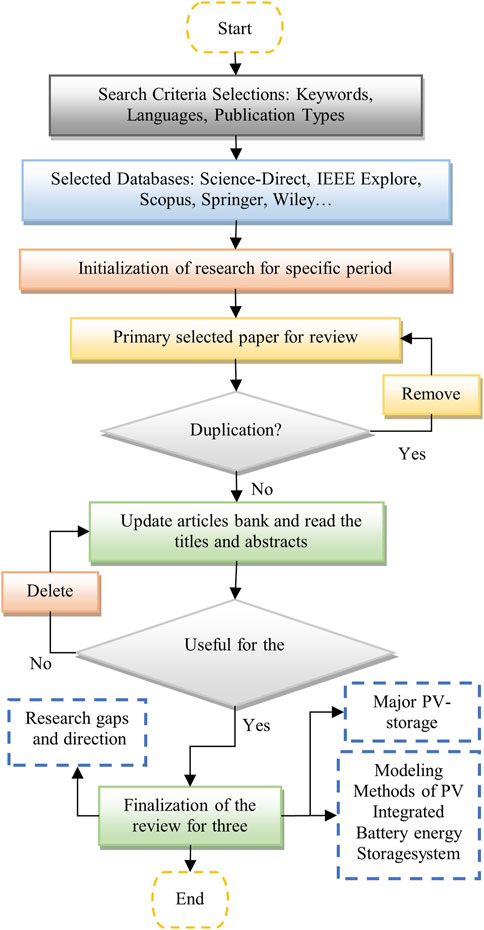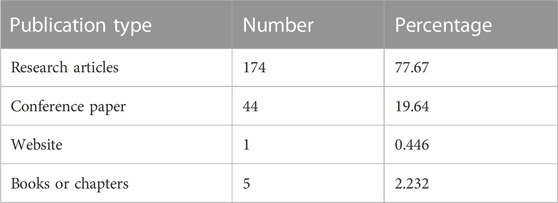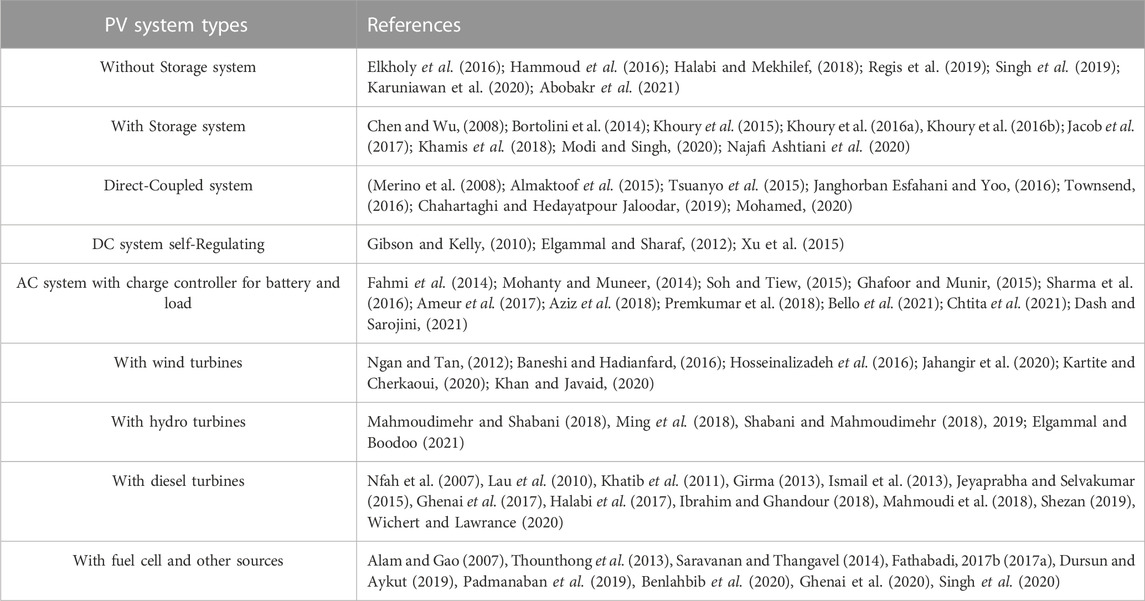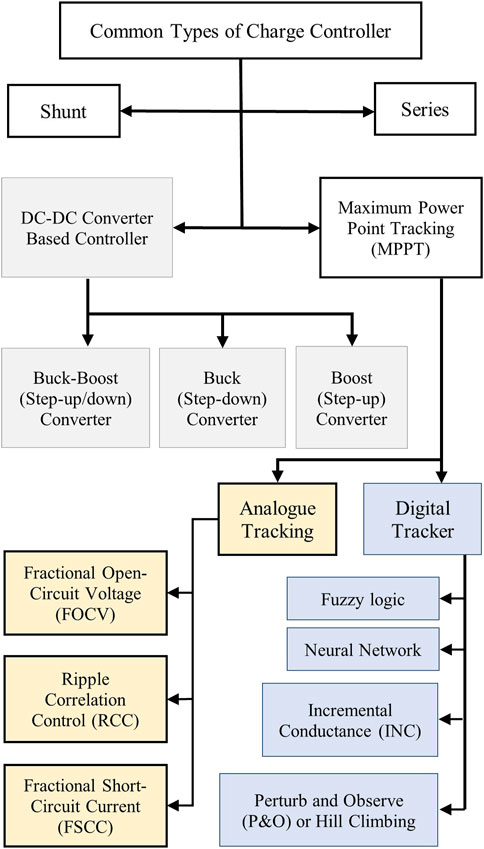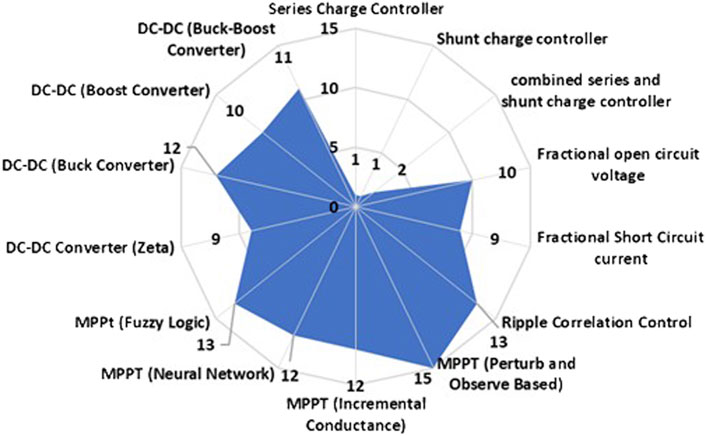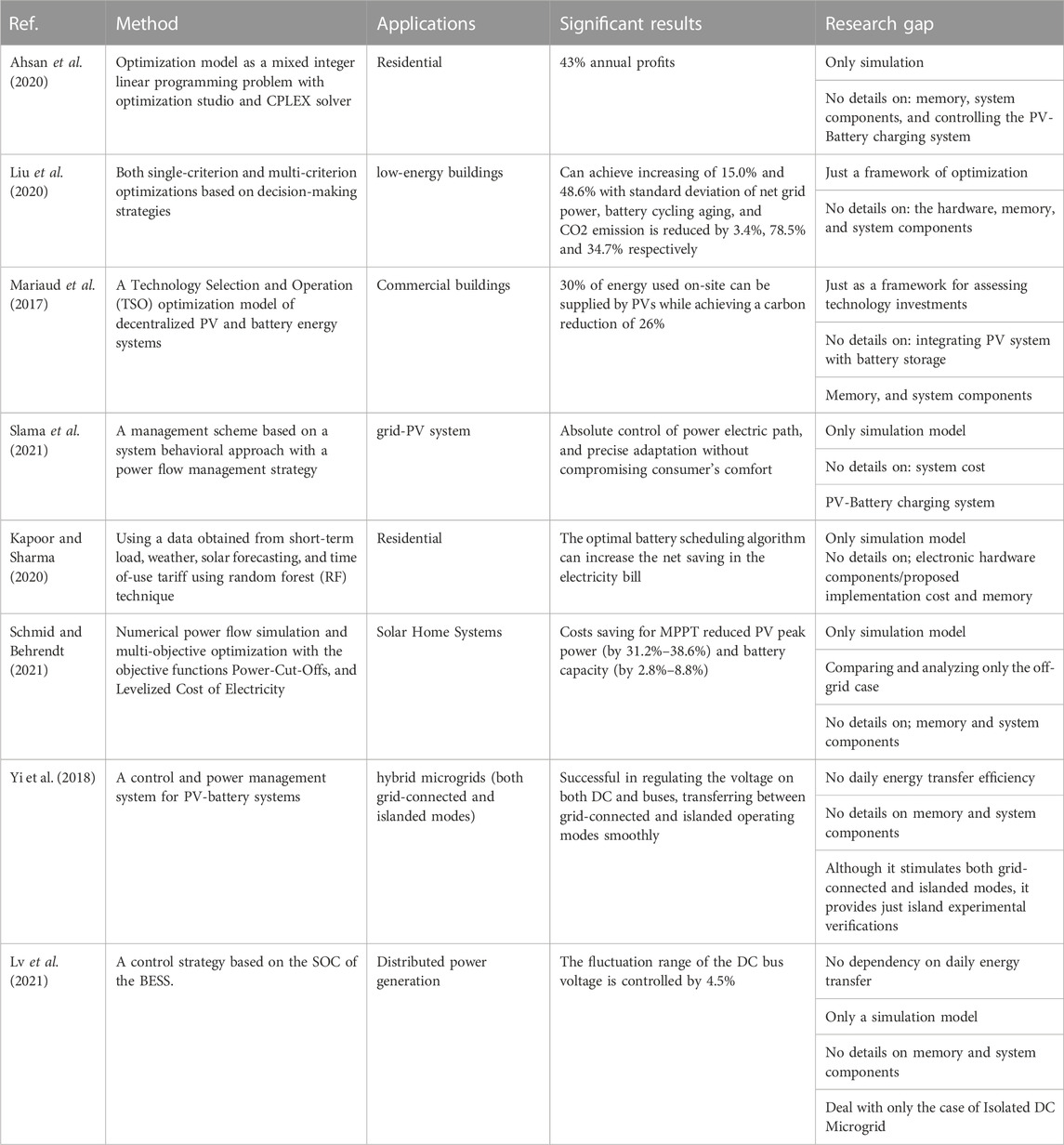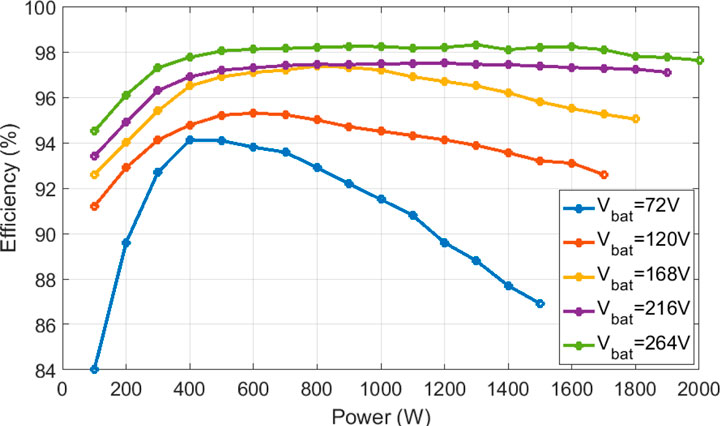- 1Electrical & Electronics Engineering, Mugla Sıtkı Kocman University, Mugla, Turkey
- 2The Center for Solar Energy Research and Applications (GUNAM), Ankara, Turkey
Solar photovoltaic (PV) microgrids have gained popularity in recent years as a way to improve the stability of intermittent renewable energy generation in systems, both off-grid and on-grid, and to meet the needs of emergency settings during natural catastrophes. Over the last several decades, researchers have been interested in improving the efficiency of photovoltaic (PV) systems. Solar-battery charge controllers based on various algorithms are continuously and intensively employed to improve energy transfer efficiency and reduce charging time. This paper presents state-of-the-art solar photovoltaic (PV) integrated battery energy storage systems (BESS). An overview of and motivations for PV-battery systems is initially introduced, followed by the survey methodology and its contributions. In addition, this study classifies residential solar PV systems and battery charge controllers with their corresponding references in the review structure, which also provides details on battery charger topologies. Subsequently, an analytical review of the PV-Battery charge controller and the failure probability of such systems is discussed to determine the system components that mostly fail and their importance in the system. Finally, recommendation amendments to the existing charge controller that potentially contribute to increasing the system efficiency, reducing the failure probabilities, and reducing the cost are presented as future design concepts for the entire system.
1 Introduction
In recent years, photovoltaic (PV) microgrids have gained attention as a potential solution for enhancing the reliability of intermittent renewable energy generation in systems, off-grid stand-alone or on-grid, and during unexpected emergencies resulting from natural disasters. Due to the severe energy crisis and environmental pollution in recent years, solar energy has received major consideration. One of the most popular sources of electrical energy today is photovoltaic technology, which converts solar radiation directly into electricity. They can be utilized in stand-alone mode to supply some islanded loads or in grid-connected mode to support the network. Because weather circumstances (such clouds and fog) have a substantial impact on the solar energy received by a PV array, the PV alone cannot serve loads in stand-alone mode. Batteries and other energy storage devices are so necessary. The batteries and PV array are both DC sources, thus they are joined to the DC bus by DC-DC converters.
Over the last several decades, photovoltaic (PV) systems and their efficiency improvements have become a core research field. In addition to efficiency improvement, it is very important to be able to transfer and store energy correctly and effectively. Continuous and intensive efforts have been made to productively manage energy transfer. One of the most crucial actions is to reduce the charging time using solar-battery charging controllers based on different algorithms. A key aspect of PV-powered microgrids is the energy conversion efficiency during the daytime by maintaining the local charging voltage, which is highly influenced by load and generation fluctuations. The charge controller plays a vital role in controlling the voltage to charge the battery to an appropriate voltage level equivalent to its full state of charge (SOC). It also prevents reverse current flow when solar power is not available, and overcharging when the PV energy exceeds the electrical load demand.
Designing a supervisory controller that can increase battery lifespan, reduce self-discharge rate, and produce high energy concentration is one of the key difficulties for battery energy storage systems. A regulatory State of Charge (SOC) calculation based on PV-Battery Management System (BMS) that best handles these problems (Yonis Buswig et al., 2020). A standalone PV integrated battery system has a number of significant concerns including the output voltage quality, system price, system on/off mode, battery charge and discharge pattern, battery lifetime, system weight, suitable protection strategy, MPPT capacity, controllability, efficiency, etc. These characteristics are influenced by the control strategy, energy management system, configuration, DC-DC converter type, battery and PV array size, control strategy, and MPPT algorithm. Therefore, adjusting and choosing the aforementioned parameters correctly is the most important duty for designers of PV systems; hence, PV charge controller (Sabry et al., 2015; Bogno et al., 2017; Salman et al., 2018; Al-Quraan and Al-Qaisi, 2021; Kumar et al., 2021; Sabry and Hussein, 2021; Aboagye et al., 2022).
The high initial cost of the system is the main barrier to deploying battery integrated PV technology in the residential sector. However, if the system’s design analysis is carried out in terms of the system’s components, failure probability, and longevity, it could ultimately prove to be a useful solution. PV electricity utilization is still in its infancy in developing nations. People may be persuaded to support the development of this technology in the nation by the right design and user-friendly provision of photovoltaic electricity. Under order to provide the necessary electrical energy for a small residential dwelling in the climatic conditions, this research concentrates on the design topologies analysis and failure probability for an off-grid and on-grid PV system.
2 Survey methodology
Several studies have been conducted for purposes similar to those proposed in this study. Each approximation and advance are unique. When conducting an effective survey on a research topic, it is critical to begin by adopting a precise approach. Some techniques have been proposed in the literature to conclude meaningful systematic conditions of art (Denyer and Tranfield, 2009; Kluge et al., 2019). The approach used to create the state-of-the-art solar PV-integrated Battery Energy Storage system (BESS) is described in the next section. The search was limited to online published items such as research articles, review papers, conference proceedings, scientific books, and standards. To complete this review, databases such as Scopus, IEEE Explore, Science Direct, Springer, Taylor & Francis, and Wiley publishers were thoroughly searched. Keywords and scientific terms used in the search stage include “power system blackout,” “power outages,” “power system emergencies,” “cascading events,” and “methods for blackouts and cascading events”. Studies published in ISI and Q1, Q2, and Q3 journals have been investigated in detail to avoid missing any useful and helpful data. In addition to the aforementioned sources, IEEE conference materials were combined for helpful information, and IEEE standards and reports from other countries’ energy sectors were scrutinized. Several studies have reported similar results. A meticulous simplification process was performed to avoid repetition. As a result of detailed research, the most related content was examined and thoroughly analyzed by a group of subject matter specialists. A summary of the PV-integrated BESS is presented in the flowchart in Figure 1.
As stated in the above methodology flowchart and review process, the selection criteria for publications are based on keywords, publication type, and content from high-quality database publishers. A particular recent period was specified, depending on the number of extracted publications subject to content duplication. Publications were also subjected to another filter on their compatibility with review goals. Finally, publications were classified into major PV-Storage systems, research gaps, and modeling.
As stated above, different types of publications were reviewed, and a summary is presented in (Table 1). Considering the number of studies shown here, journal articles covered the majority of the reviewed research, while only 44 conference papers were considered informative.
This study includes documents published online between 2005 and 2022. It should be noted that the topic of the papers was limited, and we focused on reviewing the major PV-integrated BESS. Furthermore, the research aims to provide insight into Solar PV integrated BESS and topologies. During the research, it was found that there is a lot of interest in the prospects of PV-integrated BESS.
3 Contributions
This paper’s major contributions can be summarized as follows.
• A general overview of the principles for solar PV-integrated BESS and its characteristics, as well as knowledge of extreme weather occurrences and their devastating consequences.
• Discussion of the differences in the efficiency calculation of solar PV-integrated BESS.
• A PV-integrated battery energy-storage framework provides a general understanding of such systems.
• An important contribution is to present a comprehensive assessment of current research on proactive solar PV integrated battery energy storage enhancement measures. The use of the voltage-balancing concept for strengthening the solar PV-integrated BESS is one of these solutions, which has been fully discussed in this study.
• A brief discussion on failure probability statistics for the system components of solar PV-integrated BESS including failure rates per unit hour of the PV-battery systems.
4 Review structure
4.1 Classification of residential solar pv system
A good classification study is shown in (Figure 2)for residential solar PV systems, as conducted by (Pennstate, 2022), which is the most cited article related to this concept. In this regards (Table 2), in the present study is a compilation of PV system classifications discussed in previous literature on the topic. Grid-connected and stand-alone PV systems are two types of PV systems used. Grid-connected PV Systems and Stand-alone PV Systems are the two subcategories of PV systems. Those grid-connected PV systems that are Directly Connected to the Utility and those that are Categorized as Bimodal PV Systems can be further divided into two groups. Systems that are classed as Bimodal PV Systems do have storage systems, but systems that are Directly Connected to the Utility do not. Without battery, with battery, and hybrid PV systems are the three subcategories of stand-alone PV systems. Direct-coupled systems are systems without batteries, while self-regulating DC systems or AC systems with a charge controller for the battery and load can be systems with batteries. Systems featuring wind turbines, hydroelectric turbines, and solar panels can all be included in hybrid PV systems.

FIGURE 2. Classification of residential solar PV systems (Pennstate, 2022).
Grid-connected PV systems are further divided into two types: direct utility connections and bidirectional PV systems (Melath et al., 2020). Directly connected to utility networks do not have storage; however, bimodal PV systems do. With or without a battery, hybrid PV systems are the three types of standalone PV system. Direct-coupled systems do not have batteries, whereas self-regulating DC or AC systems with a charge controller for the battery and load contain batteries. Wind turbines, hydro turbines, diesel generators, fuel cells, and other sources can all be included in hybrid photovoltaic (PV) systems. Most studies presented in the classification study are explained in detail in the following section.
4.2 Classification of battery charge controllers
Maximum power point tracking (MPPT) is a common approach in both PV controllers (battery charger and inverter) to maintain the adjustment of the impedance faced by the PV and maintain a system operating very close to the peak power value of the PV array under varying conditions. The conditions are represented mainly by the solar irradiance (Irr), cell temperature (T), and load. Applications of predictable, continuous, and small-sized loads can be configured to operate without using a battery charge controller (Harrington, 1992; Abu Eldahab et al., 2016). The classification of common charge controller methods is shown in (Figure 3).
The evolution of a handful of PV-Battery charge controller systems has been studied in the literature, particularly in recent years. The focus of this topic is inspired by the ever-increasing demand for trusted charge controller techniques (Othman, 2020; Tan et al., 2020; Chtita et al., 2021). As a result of that, the performance of all contemporary charge controller technologies proposed in the literature is observantly evaluated in this section. Specifically, this study divided advanced battery charge controller approaches into 14 groups. Based on this methodology, each technique controls the power flow from the PV to the battery(Table 3).and the wheel chart illustrated in (Figure 4) depict the full region of inquiry in terms of PV battery methodologies.
TABLE 3. The reference table according to the classification of PV-battery charge controller systems.
It is observed in this figure that the charge controller technology with Perturb and Observe technique was the most common MPPT algorithm considered in the past studies as a battery charge controller, which is followed by Incremental Conductance based and the Ripple correlation control. In contrast, the series-based, shunt-based, and the combination between them are the methods that are less used in the previous presented topologies. This result was not surprisingly due to the advances in digital electronics and the corresponding efficiencies of these technologies. However, the digital controllers are less sensitive and lower reliability due to their complexity.
Each technique is thoroughly examined in the following subsections, which also include a summary of several research papers in each category. The wheel chart summarizes the limited number of studies that have mainly considered shunts, series, and their combinations to transfer solar PV energy to batteries. A comparison of the significant results and research gaps is presented in (Table 4).
It can be seen that the control problems of energy transfer for the PV microgrid and the mismatching sags of the DC grid voltage are rarely highlighted. All published studies compete on the fast tracking of MPPs rather than evaluating systems by the efficiency factor of the energy conversion/transfer over an entire day. The difficulty lies in using a high sampling frequency to obtain the MPP values. This issue is crucial for MPPT in grid-tied PV systems without batteries that require high-speed processors and memory. These high switching frequencies can increase the stress on power modules and reduce their operating lifetimes (Jia et al., 2018). Therefore, switching with a relatively lower frequency and DC voltage balance plays a crucial role in power quality and reliability.
4.3 Battery charger topologies
A general topology diagram for a buck-boost converter-based charge controller is shown in (Figure 5A) (Lokeshreddy et al., 2017; Maithili and Kanakaraj, 2019).
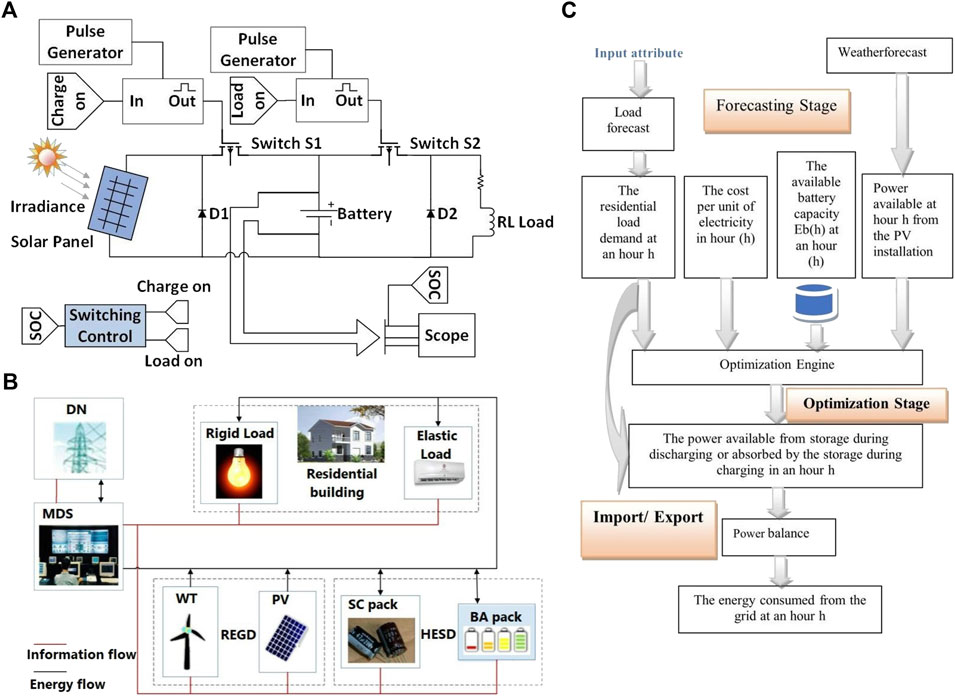
FIGURE 5. General-topology diagram for (A) buck-boost converter-based charge controller.(B) Energy dispatch scheduling of grid-connected solar PV system with battery storage (Jing et al., 2022). (C) Ideal charging and discharging schedule for a hybrid PV-battery system (Kapoor and Sharma, 2020).
Owing to its characteristics, the lead acid battery was chosen for charging and discharging the series and shunt charge controllers. The authors employed MOSFETs for switching to reduce switching losses. The proposed charge controller was created in MATLAB and the charging and discharging processes of the constructed charge controller were tested (Lokeshreddy et al., 2017).
An energy management system (EMS) algorithm for a PV grid-linked system integrated with a storage system was presented in (Slama et al., 2021) to reduce PV component redundancy, which affects grid stability. The PV and energy storage systems were connected to the same DC bus in the simulation model, and the EMS provided control over the power flow from the PV generator to the grid, based on a predetermined PV power level. When the PV power falls below a predetermined threshold, energy is saved in the batteries, which can be used during peak energy demand (PED) periods. Otherwise, it continued to supply the main grid. The system topology is shown in (Figure 5B).
An ideal charging and discharging schedule for a hybrid PV-battery system installed on a residential customer’s premises was proposed in (Kapoor and Sharma, 2020). The scheduling method was designed to reduce customers’ electricity bills. Short-term load, weather, and solar forecasting data were used in the proposed approach. This utility is expected to establish a time-of-use rate plan. This method was applied to a test with a real-world household load and solar-generation situation. The topology used in this study is illustrated in (Figure 5C).
A hybrid electric car with a solar PV battery and powertrain controller (HEV) was considered in (Padmagirisan and Sankaranarayanan, 2019), as shown in (Figure 6A). The major goal of the proposed controller is to improve battery management, load regulation, and maximum power extraction from the PV panels whenever possible. A powertrain controller can be divided into two levels: lower-level controllers and high-level control algorithms. Individual tasks such as MPPT, battery charging, and load regulation are performed using lower-level controllers.
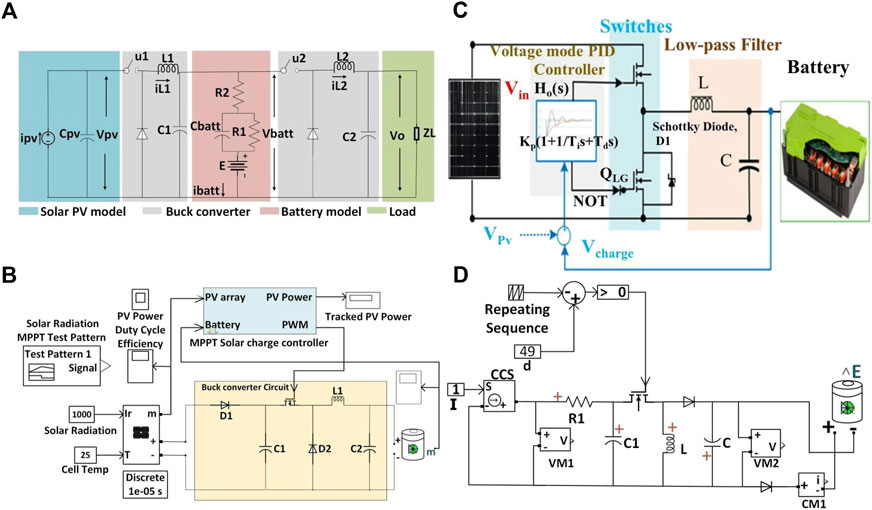
FIGURE 6. PV-Battery charge controller for (A) Hybrid electric and powertrain controller (Padmagirisan and Sankaranarayanan, 2019). (B) DC-DC buck topology and Perturb and Observe MPPT circuitry modeling for the standalone scheme (Tan et al., 2020). (C) PID controller with DC-DC buck converter (Chakraborty et al., 2018). (D) IoT-based P&O-based, MPPT, and buck-boost converter (Rokonuzzaman et al., 2020).
Reference (Tan et al., 2020) presented a buck topology and Perturb and Observe (P&O) MPPT circuitry modeling for a solar PV integrated lead acid battery charge controller for the standalone scheme in a MATLAB environment. The charge controller charges the batteries using a 3-stage charging approach, including MPPT bulk charge with a float charge stage and constant voltage absorption charge. The results showed that the MPPT can track the PV panel maximum point within 0.5 s with an overall average efficiency of 98.3%. The topology is illustrated in (Figure 6B). A PID controller with a DC-DC buck converter battery charge controller was presented in (Chakraborty et al., 2018) to charge lead-acid batteries in a solar PV array, as shown in (Figure 6C).
The experimental and simulation results confirmed that the dynamic response of this circuit was improved by considering a higher charging current and the capability to charge the battery at low irradiance, high stability, and low cost. However, the efficiency of the system was not calculated in this study.
In (Rokonuzzaman et al., 2020), an Internet of Things (IoT)-based P&O-based, MPPT, and buck-boost converter PV-battery charge controller sent vital data to the cloud for remote control and monitoring functions. The results showed that the attained efficiency approached 99.74% during 1 month of performance testing duration. The circuit diagram is shown in (Figure 6D).
Because of temperature and irradiance variations, there are difficulties with non-linearity and power fluctuations in the PV panel coupled storage system and grid. To overcome this problem, three aspects of control were combined in (Marhraoui et al., 2020a), as illustrated in (Figure 7A). The first section is devoted to devising an algorithm to minimize non-linearity to achieve MPPT by controlling the duty cycle of the DC/DC boost converter. Next, two algorithms were combined: Fuzzy Logic and Integral Backstepping (Fuzzy Logic-Integral Backstepping Controller). Then, the Integral Backstepping approach to construct the law control based on the Lyapunov theory to improve the PV-connected storage system and the grid’s robustness and stability were considered.
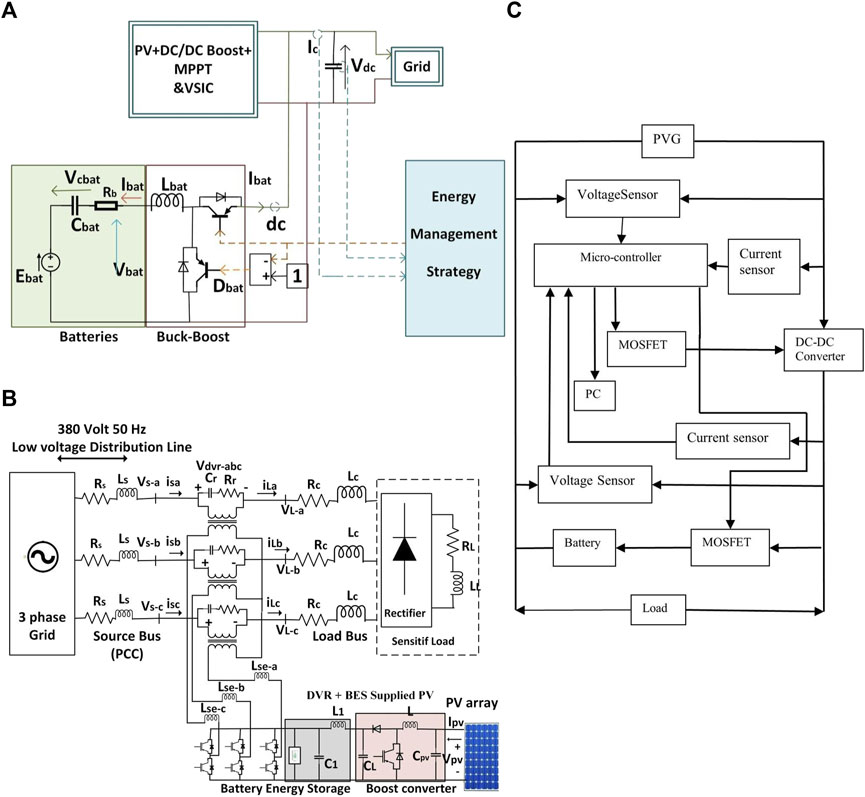
FIGURE 7. PV-Battertopology diagram for (A) a control management algorithm on the DC/DC side using VSIC as a charge controller for the stability of the grid parameter (Marhraoui et al., 2020b). (B) MPPT-based FS and MPPT-FM methods connected to 3-phase three-wire distribution network (Kiswantono et al., 2019).(C) P&O-based MPPT triggered by PWM system (Situmorang et al., 2019).
The cited paper (Kiswantono et al., 2019) presented a comparative performance between the MPPT-based Fuzzy Sugeno (FS) and MPPT-fuzzy Mamdani (MPPT-FM) methods on a PV battery system connected to 3-phase three-wire distribution network. This study stated that MPPT-FM can provide better performance in terms of the percentage of load voltage than MPPT-FS. The battery storage system is illustrated in (Figure 7B).
A P&O-based MPPT triggered by Pulse Width Modulation (PWM) with an Arduino board ATMega 328 microcontroller and MOSFET was used (Situmorang et al., 2019). Although the input voltage fluctuated slightly, the tracking output voltage was higher than the input voltage value and practically constant. The use of MPPT in the battery charging process resulted in a charging time of 8 h without MPPT, and 3 h and 20 min after utilizing MPPT. The battery storage system is illustrated in (Figure 7C).
A three-stage (bulk, absorption, and float) MPPT Buck Converter PV-Battery charge controller for improving charging/discharging was proposed in (Abdul Rahman et al., 2020). The results demonstrate that the time required to fully charge the battery decreases with the application of MPPT in the bulk stage. The circuit diagram used in this study is shown in (Figure 8A).
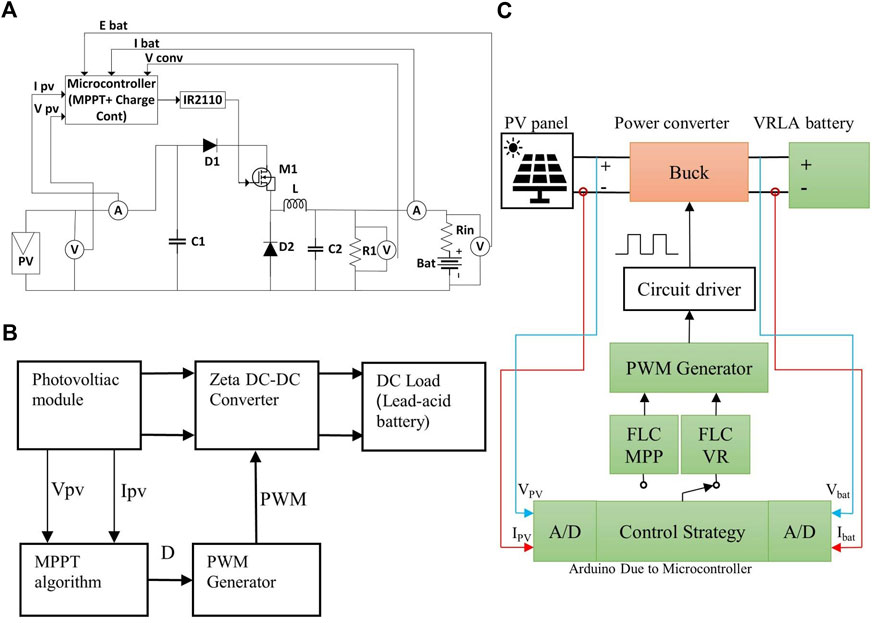
FIGURE 8. Schematic diagram for pv-battery charge controller based on (A) A three stages (bulk, absorption, and float) mppt buck converter (Abdul Rahman et al., 2020). (B) P&O-based MPPT-based Zeta converter (Ananda-Rao et al., 2020b). (C) Buck converter, two FLCs MPPT (Seguel and Seleme, 2021).
A P&O-based MPPT-based Zeta converter was used in (Ananda-Rao et al., 2020a) to drive a lead-acid battery as a load, as shown in (Figure 8B).
In (Seguel and Seleme, 2021), a buck converter and two fuzzy logic controller (FLCs) MPPT PV-Battery charge controllers were proposed. The proposed control strategy has the advantage of obtaining the most energy from the PV panel while avoiding battery damage caused by fluctuating MPPT voltages, thereby extending the battery lifetime. It also eliminates the disadvantages of traditional solar chargers, which become slow or inaccurate when weather conditions suddenly change. This technique was implemented using a low-cost Arduino AT91SAM3X8E microcontroller, as shown in (Figure 8C).
In (Shufian et al., 2021), a smart irrigation system was introduced to improve the production efficiency of an automatic irrigation control system with sensors, solar panels, fast chargers, and batteries. These sensors detect moving water, both above and below the ground. An Arduino microcontroller was used for this setup. The ESP8266 online Wi-Fi module was used to control the automated online monitoring and receive sensor responses. A fast charger was used as backup. The entire circuit is more efficient, and can be operated both automatically and manually. The block diagram of the system is shown in (Figure 9A).
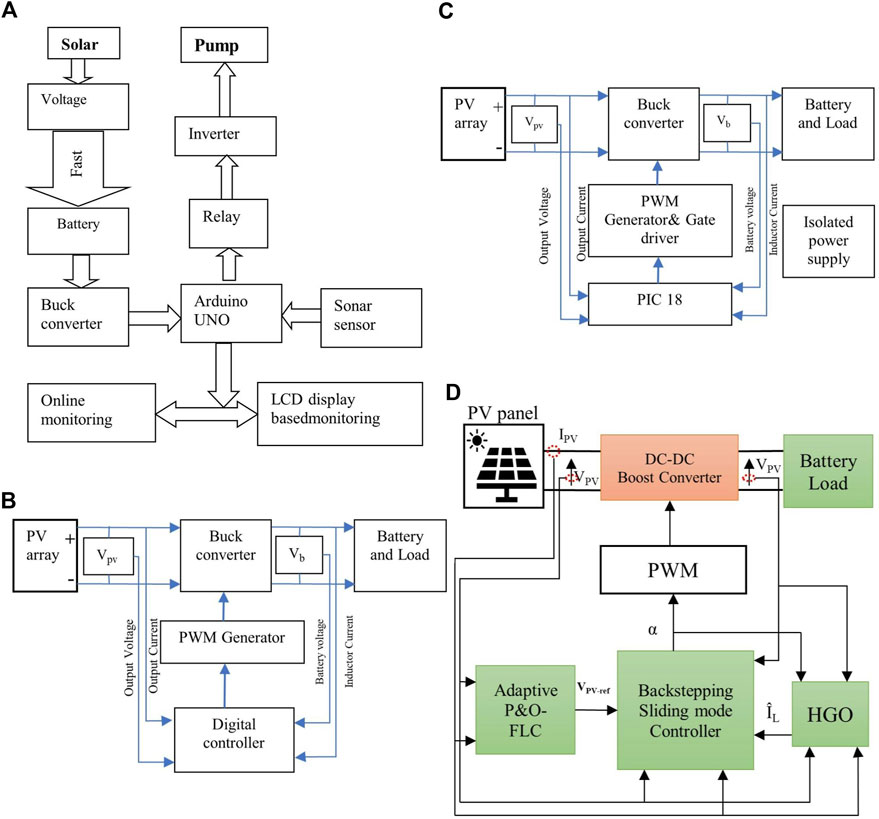
FIGURE 9. A PV-Battery charging system as (A) introduced within a smart irrigation system to improve production efficiency (Shufian et al., 2021). (B) based on PI controller (Chtita et al., 2021). (C) Implemented by a DC-DC boost converter in a PWM signal (Sansare et al., 2018). (D) MPPT-based boost converter with a combination of the adaptive P&O fuzzy logic controller MPPT and (BS-SMC) technique (Sansare et al., 2018).
In (Chtita et al., 2021), an improved power balance control strategy based solely on two proportional and integral (PI) compensators was proposed, which can effectively balance the PV power flow delivered to the DC load and battery, allowing the PV power to be effectively utilized and the battery to be properly charged. To simplify the design of the PI compensators, the complete system was modeled using a linear PV array model as the starting point. In addition, four operating modes were developed to address the aforementioned concerns regarding the weather and load demand variations. The results showed that the proposed control approach performed well in power balancing and MPPT control under a variety of atmospheric conditions, particularly in terms of efficiency (99.79%). A block diagram of the system is shown in (Figure 9B).
Using a PWM-based voltage-controlled boost converter and MATLAB, an example of this work in reference (Sansare et al., 2018) offered a design arrangement with the fewest components to produce an efficient standalone solar energy battery charger for a 40Ah, 48 V lead acid battery system. To create the boost topology in a PWM power converter, we employ a power MOSFET as a switching device, which is controlled in a switching-on and switching-off manner to manage the duty cycle of the power MOSFET. With an increased converter switching frequency, PWM power converters solve the low-efficiency issue of traditionally used linear power converters. A block diagram of the system is shown in (Figure 9C).
The design and implementation of an MPPT-based boost converter for a stand-alone PV-Battery system are presented in (Bjaoui et al., 2019). The control scheme was a combination of the adaptive P&O fuzzy logic controller (P&O-FLC) MPPT and backstepping sliding mode control (BS-SMC) technique. The results showed that this system provides near-perfect tracking in terms of dynamic response, steady-state error, and overshoot and offers greater stability and robustness than a traditional PI controller. A block diagram of the proposed scheme is shown in (Figure 9D).
In (Nagaiah and Sekhar, 2020), a topology for fuzzy-based battery energy management in a hybrid solar and wind renewable system was presented. The system includes a unidirectional boost converter and battery storage with a bidirectional DC-DC converter. The system topology is shown in (Figure 10A).
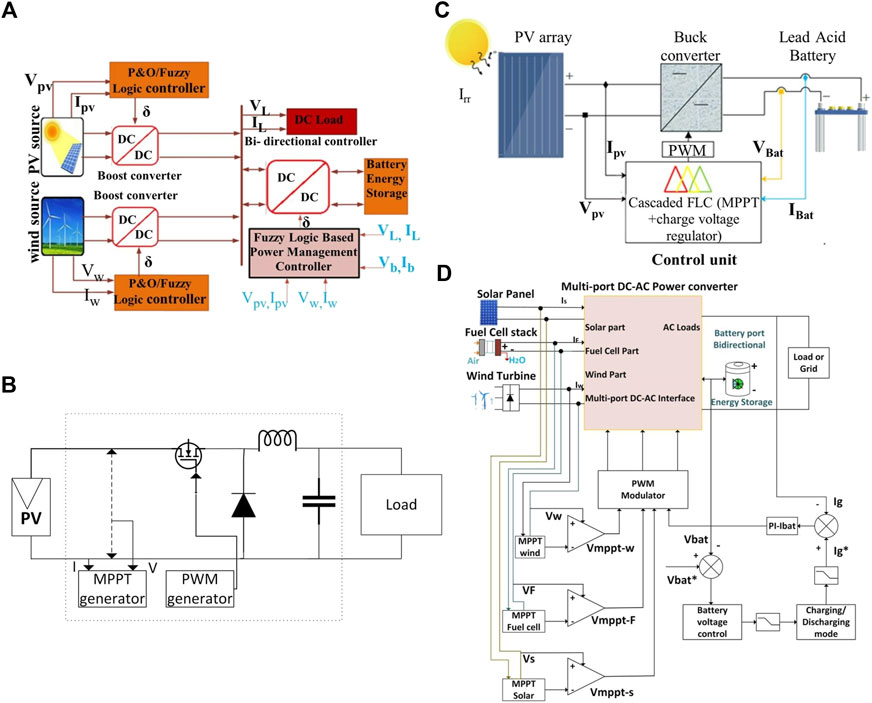
FIGURE 10. PV-Battery charge controller topology using (A) Fuzzy-based battery energy management in a hybrid solar and wind renewable system (Nagaiah and Sekhar, 2020). (B) A PWM for fast battery charging (Mehmood et al., 2016). (C) incorporates two cascaded FLC (Rkik et al., 2021). (D) A multi-port DC-DC power converter (Almutairi et al., 2021).
A previous study (Sudiharto et al., 2021) presented a PV-Battery charge controller topology using Pulse Width Modulation (PWM) for fast battery charging. The duty cycle value was modified using fuzzy control to ensure that the converter output matched the setpoint. Based on the simulation results, the study’s control obtained an output current of 12 A with an erroneous ripple current of 8.3%. After 45 min, the battery’s SOC climbed by 75.74%. The system diagram is shown in (Figure 10B).
The modeling of an intelligent combined MPPT and lead acid battery charger controller for freestanding solar PV systems was presented by the study cited in (Rkik et al., 2021). It entails controlling a DC/DC buck converter via a control unit that incorporates two cascaded FLC that modify the converter’s required duty cycle based on the SOC and the three-stage lead acid battery charging system. The first FLC (FLC1) is an MPPT controller that extracts the maximum power from the PV array, whereas the second FLC (FLC2) is responsible for controlling the voltage across the battery to ensure the three-stage charging technique. A diagram of the system is shown in (Figure 10C).
A multiport DC-DC power converter was proposed to deal with the intermittent nature and delayed reaction of renewable energy applications (Almutairi et al., 2021). In addition to the energy storage unit, the proposed converter incorporates a DC-DC converter and a DC-AC inverter, and the proposed circuit incorporates several renewable energy sources. The impact of intermittency can be significantly reduced by combining renewable energy sources with a statistical tendency to offset each other. This combination improved the overall dependability and usability of system. A diagram of the system is shown in (Figure 10D).
5 Solar-battery charge controller
Generally, PV systems have two main problems: energy conversion efficiency when the generated power is low, and the effects of weather conditions on the generated power. Furthermore, the non-linear characteristics of the I-V and P-V relationships of a PV system cause its output power to change continuously with surrounding conditions. To overcome this issue, MPPT and alternative techniques are required. The reason for this is to ensure that the optimal employment of PV cells is achieved. The major obstacle to the inability of optimal employment is the possibility of a mismatch between the load characteristics and MPPs of the PV system. In this study, techniques such as the incremental (INC) Algorithm, P&O, and FOCV were assessed for comparison with the proposed approach (Rezk and Eltamaly, 2015). The characteristic equations of a PV array (Saadeh et al., 2018) can be demonstrated as follows: the short-circuit point, slope at the short-circuit point, slope at the open-circuit point, PV current at the MPP, and
For any point (
where
The theoretical MPP values used to evaluate the simulation and experimental results are obtained from (4) and (5), where the MPP points are obtained from the relation
Referring to most PV-battery topologies, this work conducted an experiment showing the effect of source-load voltage balancing to reduce the conversion losses is evaluated by measuring the efficiency versus output power at different battery voltages ranging from 72 V to 264V, which represents 6–22 units of the 12 V battery. This result is shown in (Figure 11).
The result shows that the circuit performs a lower efficiency at a lower level of battery voltages, which is agreed with the findings of (Siraj and Khan, 2020). Therefore, higher potential difference, between the source and battery, lower energy transfer that enhances the proposed voltage-matching concept.
6 Failure probability statistics of PV-battery systems
In this paper, we briefly discuss the failure probability statistics of a solar PV-integrated BESS, which is essential for the design and implementation of solar PV systems. Although advances in power electronics and commercially widespread devices with lowered prices play a significant role in the design and PV system applications, the failure probability and lifespan of these components remain major unsolved problems. It is worth mentioning that power conversion devices from DC to AC, represented by inverters, are more complicated and have more electronics in their design than AC-DC rectifier circuits. In the same context, the DC-DC converters of the PV-Battery charge controllers are more complex than linear DC-DC converters. In addition, the various techniques of using MPPT algorithms also contribute to adding complexity and, therefore, increasing the failure probability of PV systems.
Several studies have discussed the issue of failure probabilities in solar PV system components (Abed and Mhalla, 2021; Ghaedi and Gorginpour, 2021; Ostovar et al., 2021; Shashavali and Sankar, 2021; Firouzi et al., 2022). (Table 5) lists the failure rates per unit hour of the PV-battery systems (Abdon et al., 2020). The results show that the DC-AC power inverters had the highest failure rate per unit hour of the PV-Batter systems, as expected.
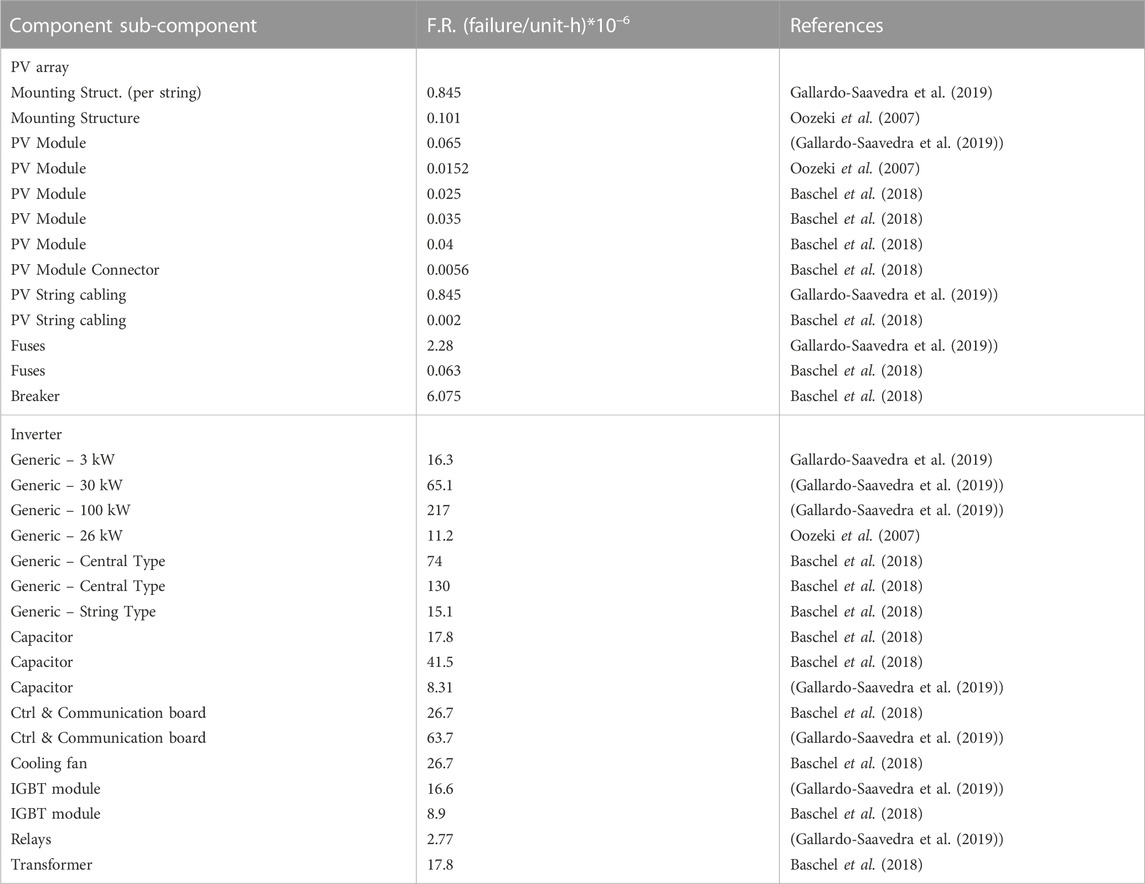
TABLE 5. Failure rate per unit hour of PV-Battery systems (Abdon et al., 2020).
7 Conclusion
To reduce the number of power conversion stages and the cost of power modules, and to meet the maximum energy transfer efficiency, it is necessary to enhance the flexibility and efficiency of energy transfer. Moreover, research efforts are required to eliminate losses owing to high-frequency switching devices and the complexity of using multiple hardware. In addition, the presented work validates the effectiveness of the proposed concept by evaluating the energy transfer efficiency through simulations and experimental measurements over the entire day. The functionality of a PV-battery controller topology can provide the following benefits: 1) cost-effectiveness and high reliability owing to fewer electronic components, 2) resilience improvement of renewable-powered systems, and 3) lower barriers toward more deployments of PV-powered microgrid systems. Future developments in this field may be suitable for standalone and grid-tied PV systems with battery storage. The topological characteristics of a future charge controller are summarized as follows.
1) Maintaining PV-battery voltage matching will provide features for more control flexibility and enhanced reliability. Batteries with different SOC and capacity conditions can be connected to different solar PVs based on balancing the DC bus voltage, and the MPP is maintained further by controlling the temperature of the PV modules. Compared with a conventional charger that requires power-switching modules with a high operating frequency, only a low-frequency switching power module is required to drive cooling fans.
2) Compared with the conventional charge controller, the DC-DC conversion stage can be removed not only from the stage between the PV and battery but also from the battery-load stage. This configuration leads to a reduction in hardware costs and improvements in system efficiency.
3) This review presented a brief discussion on failure probability statistics for the system components of solar PV-integrated BESS including failure rates per unit hour of the PV-battery systems. The statistical results demonstrated that the DC-AC power inverters had the highest failure rate per unit hour of the PV-Batter systems.
4) As a future solar PV integrated battery energy storage system, to reduce the number of power conversion stages and obtain maximum energy transfer efficiency, a fundamentals-based algorithm and topology, without the integration of DC-DC converter, is proposed. Moreover, the voltage control issue in the DC microgrid is treated as an optimization problem to minimize the hardware complexity and the losses of high-frequency switching devices. The presented work validates the effectiveness of the proposed concept via the evaluation of the energy transfer efficiency in simulations and experimental measurements over a full daytime. The functionality of the proposed topology can provide benefits such as 1) cost-effective and high reliability due to lower electronic components, 2) resilience improvement of renewable-powered systems and 3) lower barriers toward more deployments of PV-powered microgrid systems.
Author contributions
MH: performed the research, Data Analysis, Writing–Reviewing and Editing. SA: review, editing, and supervision. All authors have read and agreed to the published version of the manuscript.
Conflict of interest
The authors declare that the research was conducted in the absence of any commercial or financial relationships that could be construed as a potential conflict of interest.
Publisher’s note
All claims expressed in this article are solely those of the authors and do not necessarily represent those of their affiliated organizations, or those of the publisher, the editors and the reviewers. Any product that may be evaluated in this article, or claim that may be made by its manufacturer, is not guaranteed or endorsed by the publisher.
References
Abdon, E., Zúñiga, A., Costa Branco, P. J., and Pereira Fernandes, J. F. (2020). “Failure rates in photovoltaic systems: A careful selection of quantitative data available in the literature,” in Conference: European Photovoltaic Energy Conference and Exhibition EUPVSEC 2020, Lisbon, Portugal, September 2020.
Abdul Rahman, N. H., M. Omar, A., Mat Saat, E. H., I. Ilham, N., Z. Hussin, M., and Y, Y. (2020). Design and development of three stages maximum power tracking solar charge controller. Indonesian J. Electr. Eng. Comput. Sci. 18 (3), 1270. doi:10.11591/ijeecs.v18.i3.pp1270-1278
Abdul-Razzaq, I. K., Fahim Sakr, M. M., and Rashid, Y. G. (2021). Comparison of PV panels MPPT techniques applied to solar water pumping system. Int. J. Power Electron. Drive Syst. 12 (3), 1813. doi:10.11591/ijpeds.v12.i3.pp1813-1822
Abed, M. J., and Mhalla, A. (2021). “Adequate reliability assessment of solar PV generator based dc chopper,” in 2021 12th International Renewable Energy Congress, IREC, Hammamet, Tunisia, 26-28 October 2021. doi:10.1109/IREC52758.2021.9624886
Aboagye, B., Gyamfia, S., Ofosua, E. A., and Djordjevic, S. (2022). Investigation into the impacts of design, installation, operation and maintenance issues on performance and degradation of installed solar photovoltaic (PV) systems. Energy Sustain. Dev. 66, 165–176. doi:10.1016/j.esd.2021.12.003
Abobakr, H., Diab, A., Hassan, Y. B., and Khalaf, A. (2021). Performance analysis of a small-scale grid-connected photovoltaic system:a real case study in Egypt. J. Adv. Eng. Trends 40 (1), 79–96. doi:10.21608/jaet.2021.82233
Abu Eldahab, Y. E., Saad, N. H., and Zekry, A. (2016). Enhancing the design of battery charging controllers for photovoltaic systems. Renew. Sustain. Energy Rev. 58 (5), 646–655. doi:10.1016/j.rser.2015.12.061
Ahmad, M., Numan, A., and Mahmood, D. (2022a). A comparative study of perturb and observe (P&O) and incremental conductance (INC) PV MPPT techniques at different radiation and temperature conditions. Eng. Technol. J. 40 (2), 376–385. doi:10.30684/etj.v40i2.2189
Ahmed, E. M., Norouzi, H., Alkhalaf, S., Ali, Z. M., Dadfar, S., and Furukawa, N. (2022b). Enhancement of MPPT controller in PV-BES system using incremental conductance along with hybrid crow-pattern search approach based ANFIS under different environmental conditions. Sustain. Energy Technol. Assessments 50, 101812. doi:10.1016/j.seta.2021.101812
Ahsan, S. M., Khan, H. A., Hassan, N. u., Arif, S. M., and Lie, T. T. (2020). Optimized power dispatch for solar photovoltaic-storage system with multiple buildings in bilateral contracts. Appl. Energy 273, 115253. doi:10.1016/j.apenergy.2020.115253
Al Kader Hammoud, H. A., and Bazzi, A. M. (2020). “Model-based MPPT with corrective ripple correlation control,” in 2020 IEEE Power and Energy Conference at Illinois, PECI, Champaign, IL, USA, 27-28 February 2020. doi:10.1109/PECI48348.2020.9064681
Al-Quraan, A., and Al-Qaisi, M. (2021). Modelling, design and control of a standalone hybrid PV-wind micro-grid system. Energies 14 (16), 4849. doi:10.3390/en14164849
Alam, M. S., and Gao, D. W. (2007). “Modeling and analysis of a wind/PV/fuel cell hybrid power system in HOMER,” in ICIEA 2007: 2007 Second IEEE Conference on Industrial Electronics and Applications, Harbin, China, 23-25 May 2007. doi:10.1109/ICIEA.2007.4318677
Albatran, S., and Assad, O. (2020). Online adaptive master maximum power point tracking algorithm and sensorless weather estimation. Energy Syst. 11 (1), 73–93. doi:10.1007/s12667-018-0313-9
Almaktoof, A. M., Raji, A. K., Kahn, M. T., and Ekhlat, M. A. (2015). Batteryless PV desalination system for rural areas: A case study. J. Energy South. Afr. 26 (4), 29. doi:10.17159/2413-3051/2016/v26i4a2091
Almutairi, A., Sayed, K., Albagami, N., Abo-Khalil, A. G., and Saleeb, H. (2021). Multi-port pwm dc-dc power converter for renewable energy applications. Energies 14 (12), 3490. doi:10.3390/en14123490
Ameur, K., Hadjaissa, A., Cheknane, A., and Essounbouli, N. (2017). DC-bus voltage control based on power flow management using direct sliding mode control for standalone photovoltaic systems. Electr. Power Components Syst. 45 (10), 1106–1117. doi:10.1080/15325008.2017.1318976
Ammar, H. H., Azar, H. T., Shalaby, R., and Mahmoud, M. I. (2019). Metaheuristic optimization of fractional order incremental conductance (FO-INC) maximum power point tracking (MPPT). Complexity 2019, 7687891. doi:10.1155/2019/7687891
Ananda-Rao, K., Mansur, T. M. N. T., Baharudin, N. H., and Matar, Y. (2020b). Design of zeta converter with MPPT algorithm for solar photovoltaic application integrated with battery. Int. J. Adv. Trends Comput. Sci. Eng. 9 (5). doi:10.30534/ijatcse/2020/219952020
Ananda-Rao, K., Matar, Y., Hanisah Baharudin, N., Alif Ismail, M., and Muiez Abdullah, A. (2020a). Design of MPPT charge controller using zeta converter for battery integrated with solar Photovoltaic (PV) system. J. Phys. Conf. Ser. 1432, 012058. doi:10.1088/1742-6596/1432/1/012058
Andrade, A. M. S. S., Mattos, E., Gamba, C. O., Schuch, L., and Martins, M. L. S. (2015a). “Design and implementation of PV power zeta converters for battery charger applications,” in 2015 IEEE Energy Conversion Congress and Exposition, ECCE, Montreal, QC, Canada, 20-24 September 2015. doi:10.1109/ECCE.2015.7310099
Andrade, A. M. S. S., Schuch, L., and Martins, M. L. D. S. (2015b). “Photovoltaic battery charger based on the Zeta converter: Analysis, design and experimental results,” in IEEE International Symposium on Industrial Electronics, Buzios, Brazil, 03-05 June 2015. doi:10.1109/ISIE.2015.7281498
Anowar, M. H., and Roy, P. (2019). “A modified incremental conductance based photovoltaic MPPT charge controller,” in 2nd International Conference on Electrical, Computer and Communication Engineering, ECCE 2019, Cox'sBazar, Bangladesh, 07-09 February 2019. doi:10.1109/ECACE.2019.8679308
Atri, P. K., Modi, P. S., and Gujar, N. S. (2020). “Comparison of different MPPT control strategies for solar charge controller,” in 2020 International Conference on Power Electronics and IoT Applications in Renewable Energy and its Control, PARC, Mathura, India, 28-29 February 2020. doi:10.1109/PARC49193.2020.236559
Atri, P. K., Modi, P. S., and Gujar, N. S. (2021). “Design and development of solar charge controller by implementing two different MPPT algorithm,” in Proceedings of the 2021 1st International Conference on Advances in Electrical, Computing, Communications and Sustainable Technologies, ICAECT 2021, Bhilai, India, 19-20 February 2021. doi:10.1109/ICAECT49130.2021.9392426
Aziz, W., Kadir, M., Rahim, N., and Mohd Tumari, M. Z. (2018). Experimental study on efficiency of DC and AC power supply travel kit using solar panel. J. Telecommun. Electron. Comput. Eng. 10 (2–6).
Bagherwal, S., and Badoni, M. (2020). Design and development of standalone solar photovoltaic battery system with adaptive sliding mode controller. Int. J. Renew. Energy Res. 10 (1), 8. doi:10.20508/ijrer.v10i1.10294.g7863
Bandyopadhyay, A., and Parui, S. (2018). “Bifurcation behavior of photovoltaic panel fed Cuk converter connected to different types of loads,” in 2018 International Symposium on Devices, Circuits and Systems, ISDCS, Howrah, India, 29-31 March 2018. doi:10.1109/ISDCS.2018.8379671
Baneshi, M., and Hadianfard, F. (2016). Techno-economic feasibility of hybrid diesel/PV/wind/battery electricity generation systems for non-residential large electricity consumers under southern Iran climate conditions. Energy Convers. Manag. 127, 233–244. doi:10.1016/j.enconman.2016.09.008
Baramadeh, M. Y., Abouelela, M. A. A., and Alghuwainem, S. M. (2021). Maximum power point tracker controller using fuzzy logic control with battery load for photovoltaics systems. Smart Grid Renew. Energy 12 (10), 163–181. doi:10.4236/sgre.2021.1210010
Baschel, S., Koubli, E., Roy, J., and Gottschalg, R. (2018). Impact of component reliability on large scale photovoltaic systems’ Performance. Energies 11 (6), 1579. doi:10.3390/en11061579
Bello, R., Suleiman, T., Kende, U. A., and Abulrasheed, M. (2021). Design analysis of 7.5KW stand alone solar photovoltaic power system for an intermediate household. Asian J. Res. Rev. Phys. 2021, 18–25. doi:10.9734/ajr2p/2021/v5i130154
Benlahbib, B., Bouarroudj, N., Mekhilef, S., Abdeldjalil, D., Abdelkrim, T., Bouchafaa, F., et al. (2020). Experimental investigation of power management and control of a PV/wind/fuel cell/battery hybrid energy system microgrid. Int. J. Hydrogen Energy 45 (53), 29110–29122. doi:10.1016/j.ijhydene.2020.07.251
Bjaoui, M., Khiari, B., Benadli, R., Memni, M., and Sellami, A. (2019). Practical implementation of the backstepping sliding mode controller MPPT for a PV-storage application. Energies 12 (18), 3539. doi:10.3390/en12183539
Bogno, B., Sawicki, J. P., Salame, T., Aillerie, M., Saint-Eve, F., Hamandjoda, O., et al. (2017). Improvement of safety, longevity and performance of lead acid battery in off-grid PV systems. Int. J. Hydrogen Energy 42, 3466–3478. doi:10.1016/j.ijhydene.2016.12.011
Bortolini, M., Gamberi, M., and Graziani, A. (2014). Technical and economic design of photovoltaic and battery energy storage system. Energy Convers. Manag. 86, 81–92. doi:10.1016/j.enconman.2014.04.089
Chahartaghi, M., and Hedayatpour Jaloodar, M. (2019). Mathematical modeling of direct-coupled photovoltaic solar pump system for small-scale irrigation. Energy Sources, Part A Recovery, Util. Environ. Eff. 2019, 1–22. doi:10.1080/15567036.2019.1685025
Chakraborty, S., Hasan, M. M., Worighi, I., Hegazy, O., and Razzak, M. A. (2018). Performance evaluation of a PID-controlled synchronous buck converter based battery charging controller for solar-powered lighting system in a fishing trawler. Energies 11 (10), 2722. doi:10.3390/en11102722
Chandran, I. R., Ramasamy, S., Ahsan, M., Haider, J., and Rodrigues, E. M. G. (2021). Implementation of non-isolated zeta-ky triple port converter for renewable energy applications. Electron. Switz. 10 (14), 1681. doi:10.3390/electronics10141681
Chandrasekar, B., Nallaperumal, C., Padmanaban, S., Bhaskar, M. S., Holm-Nielsen, J. B., Leonowicz, Z., et al. (2020). Non-Isolated high-gain triple port DC-DC buck-boost converter with positive output voltage for photovoltaic applications. IEEE Access 8, 113649–113666. doi:10.1109/ACCESS.2020.3003192
Chaudhary, C., Mishra, S., and Nangia, U. (2021). “A bridgeless isolated zeta converter for battery charging aided with solar photovoltaic system,” in 2021 International Conference on Smart Generation Computing, Communication and Networking, SMART GENCON, Pune, India, 29-30 October 2021. doi:10.1109/SMARTGENCON51891.2021.9645803
Chen, X., Pise, A. A., Elmes, J., and Batarseh, I. (2019). Ultra-highly efficient low-power bidirectional cascaded buck-boost converter for portable PV-Battery-devices applications. IEEE Trans. Industry Appl. 55 (4), 3989–4000. doi:10.1109/TIA.2019.2911566
Chen, Y., and Wu, J. (2008). “Agent-based energy management and control of a grid-connected wind/solar hybrid power system,” in Proceedings of the 11th International Conference on Electrical Machines and Systems, ICEMS, Wuhan, China, 17-20 October 2008.
Chtita, S., Derouich, A., El Ghzizal, A., and Motahhir, S. (2021). An improved control strategy for charging solar batteries in off-grid photovoltaic systems. Sol. Energy 220, 927–941. doi:10.1016/j.solener.2021.04.003
Chtouki, I., Wira, P., Zazi, M., Collicchio, B., and Meddour, S. (2019). Design, implementation and comparison of several neural Perturb and Observe MPPT methods for photovoltaic systems. Int. J. Renew. Energy Res. 9 (2), 758–769. doi:10.20508/ijrer.v9i2.9293.g7645
Dash, S., and Sarojini, L. (2021). Analysis and charge control of lithium ion battery with application for off-grid PV system. J. Phys. Conf. Ser. 1714, 012001. doi:10.1088/1742-6596/1714/1/012001
Denyer, D., and Tranfield, D. (2009). The sage handbook of organizational research methods. California, United States: Sage Publications Ltd.
Dey, A. (2021). Comparison of hill climbing and perturb & observe method for PV array using DC-DC converter. Int. J. Res. Appl. Sci. Eng. Technol. 9 (VI), 4037–4041. doi:10.22214/ijraset.2021.35585
Dursun, B., and Aykut, E. (2019). An investigation on wind/PV/fuel cell/battery hybrid renewable energy system for nursing home in Istanbul. Proc. Institution Mech. Eng. Part A J. Power Energy 233 (5), 616–625. doi:10.1177/0957650919840519
El-Shahat, A., and Sumaiya, S. (2019). DC-microgrid system design, control, and analysis. Electron. Switz. 8 (2), 124. doi:10.3390/electronics8020124
Elgammal, A. A. A., and Sharaf, A. M. (2012). Self-regulating particle swarm optimised controller for (photovoltaic-fuel cell) battery charging of hybrid electric vehicles. IET Electr. Syst. Transp. 2 (2), 77. doi:10.1049/iet-est.2011.0021
Elgammal, A., and Boodoo, C. (2021). Optimal hybrid filtering strategy using adaptive genetic-fuzzy logic control for harmonics reduction in a standalone micro hydroelectric power plant coordinated with a PV system. Eur. J. Electr. Eng. Comput. Sci. 5 (4), 56–62. doi:10.24018/ejece.2021.5.4.348
Elkholy, A., Fahmy, F., Abou El-Ela, A., Nafeh, A. E. S. A., and Spea, S. (2016). Experimental evaluation of 8kW grid-connected photovoltaic system in Egypt. J. Electr. Syst. Inf. Technol. 3 (2), 217–229. doi:10.1016/j.jesit.2015.10.004
Ezzitouni, J., Ahmed, M., Mohammed, L., and Ayoub, K. (2021). Management of battery charging and discharging in a photovoltaic system with variable power demand using artificial neural networks. E3S Web Conf. 297, 01037. doi:10.1051/e3sconf/202129701037
Fahmi, M. I., Isa, D., Arelhi, R., and RajKumar, R. (2014). “Solar PV system for off-grid electrification in rural area,” in 3rd IET International Conference on Clean Energy and Technology (CEAT) 2014, Kuching, 24-26 November 2014. doi:10.1049/cp.2014.1496
Fathabadi, H. (2017b). Novel standalone hybrid solar/wind/fuel cell power generation system for remote areas. Sol. Energy 146, 30–43. doi:10.1016/j.solener.2017.01.071
Fathabadi, H. (2017a). Novel standalone hybrid solar/wind/fuel cell/battery power generation system. Energy 140, 454–465. doi:10.1016/j.energy.2017.08.098
Ferdous, S. M., Shafiullah, G. M., Moin Oninda, M. A., Shoeb, M. A., and Ja, T. (2018). “Close loop compensation technique for high performance MPPT using ripple correlation control,” in 2017 Australasian Universities Power Engineering Conference, AUPEC, VIC, Australia, 19-22 November 2017. doi:10.1109/AUPEC.2017.8282429
Firouzi, M., Samimi, A., and Salami, A. (2022). Reliability evaluation of a composite power system in the presence of renewable generations. Reliab. Eng. Syst. Saf. 222, 108396. doi:10.1016/j.ress.2022.108396
Gallardo-Saavedra, S., Hernández-Callejo, L., and Duque-Pérez, O. (2019). Quantitative failure rates and modes analysis in photovoltaic plants. Energy 183, 825–836. doi:10.1016/j.energy.2019.06.185
Ghaedi, A., and Gorginpour, H. (2021). Spinning reserve scheduling in power systems containing wind and solar generations. Electr. Eng. 103, 2507–2526. doi:10.1007/s00202-021-01239-z
Ghafoor, A., and Munir, A. (2015). Design and economics analysis of an off-grid PV system for household electrification. Renew. Sustain. Energy Rev. 42, 496–502. doi:10.1016/j.rser.2014.10.012
Ghenai, C., Salameh, T., Merabet, A., and Hamid, A. K. (2017). “Modeling and optimization of hybrid solar-diesel-battery power system,” in 2017 7th International Conference on Modeling, Simulation, and Applied Optimization, ICMSAO, Sharjah, United Arab Emirates, 04-06 April 2017. doi:10.1109/ICMSAO.2017.7934885
Ghenai, C., Salameh, T., and Merabet, A. (2020). Technico-economic analysis of off grid solar PV/Fuel cell energy system for residential community in desert region. Int. J. Hydrogen Energy 45 (20), 11460–11470. doi:10.1016/j.ijhydene.2018.05.110
Gibson, T. L., and Kelly, N. A. (2010). Solar photovoltaic charging of lithium-ion batteries. J. Power Sources 195 (12), 3928–3932. doi:10.1016/j.jpowsour.2009.12.082
Gil-Velasco, A., and Aguilar-Castillo, C. (2021). A modification of the perturb and observe method to improve the energy harvesting of pv systems under partial shading conditions. Energies 14 (9), 2521. doi:10.3390/en14092521
Girma, Z. (2013). Technical and economic assessment of solar PV/diesel Hybrid power system for rural school electrification in Ethiopia. Int. J. Renew. Energy Res. 3 (3). doi:10.20508/ijrer.08621
Goud, P. C. D., and Gupta, R. (2019). Dual-mode control of multi-functional converter in solar PV system for small off-grid applications. IET Power Electron. 12 (11), 2851–2857. doi:10.1049/iet-pel.2018.6313
Goud, P. C. D., and Gupta, R. (2020). Solar PV based nanogrid integrated with battery energy storage to supply hybrid residential loads using single-stage hybrid converter. IET Energy Syst. Integr. 2 (2), 161–169. doi:10.1049/iet-esi.2019.0030
Gupta, A. K., Pachauri, R. K., Maity, T., Chauhan, Y. K., Mahela, O. P., Khan, B., et al. (2021). Effect of various incremental conductance MPPT methods on the charging of battery load feed by solar panel. IEEE Access 9, 90977–90988. doi:10.1109/ACCESS.2021.3091502
Halabi, L. M., Mekhile, S., Olatomiwa, F., and Hazelton, J. (2017). Performance analysis of hybrid PV/diesel/battery system using homer: A case study sabah, Malaysia. Energy Convers. Manag. 144, 322–339. doi:10.1016/j.enconman.2017.04.070
Halabi, L. M., and Mekhilef, S. (2018). Performance analysis of multi-photovoltaic (PV)-Grid tied plant in Malaysia. IOP Conf. Ser. Earth Environ. Sci. 164, 012013. doi:10.1088/1755-1315/164/1/012013
Hammami, M., Ricco, M., Ruderman, A., and Grandi, G. (2019). Three-phase three-level flying capacitor PV generation system with an embedded ripple correlation control MPPT algorithm. Electron. Switz. 8 (2), 118. doi:10.3390/electronics8020118
Hammoud, M., Assi, A., Rammal, K., Ghabris, H., Salameh, W., Al-Kaaki, O., et al. (2016). “Power from photovoltaic installed in the middle of the Lebanese high-ways: PV system in the middle of the high-ways,” in 2016 3rd International Conference on Renewable Energies for Developing Countries, REDEC, Zouk Mosbeh, Lebanon, 13-15 July 2016. doi:10.1109/REDEC.2016.7577552
Harrington, S., and Dunlop, J. (1992). Battery charge controller characteristics in photovoltaic systems. IEEE Aerosp. Electron. Syst. Mag. 7, 15–21. doi:10.1109/62.151141
Hidayat, A., Muhammad, A. B., Ayub Windarko, N., and Efendi, M. Z. (2019). “Short circuit current based ANN MPPT for battery charging,” in IES 2019 - International Electronics Symposium: The Role of Techno-Intelligence in Creating an Open Energy System Towards Energy Democracy, Proceedings, Surabaya, Indonesia, 27-28 September 2019. doi:10.1109/ELECSYM.2019.8901608
Hosseinalizadeh, R., Shakouri, H. G., Amalnicka, M. S., and Taghipour, P. (2016). Economic sizing of a hybrid (PV-WT-FC) renewable energy system (HRES) for stand-alone usages by an optimization-simulation model: Case study of Iran. Renew. Sustain. Energy Rev. 54, 139–150. doi:10.1016/j.rser.2015.09.046
Ibrahim, H., and Ghandour, M. (2018). Optimization of energy management of a microgrid based on solar-diesel-battery hybrid system. MATEC Web Conf. 171, 7. doi:10.1051/matecconf/201817101006
İnci, M. (2021). A flexible perturb & observe MPPT method to prevent surplus energy for grid-failure conditions of fuel cells. Int. J. Hydrogen Energy 46 (79), 39483–39498. doi:10.1016/j.ijhydene.2021.09.185
Isknan, I., Asbayou, A., Ihlal, A., and Bouhouch, L. (2022). Benchmarking of the conductance increment method and its improved versions. ITM Web Conf. 43, 01011. doi:10.1051/itmconf/20224301011
Ismail, M. S., Moghavvemi, M., and Mahlia, T. M. I. (2013). Techno-economic analysis of an optimized photovoltaic and diesel generator hybrid power system for remote houses in a tropical climate. Energy Convers. Manag. 69, 163–173. doi:10.1016/j.enconman.2013.02.005
Jacob, A. S., Das, J., Abraham, A. P., Banerjee, R., and Ghosh, P. C. (2017). Cost and energy analysis of PV battery grid backup system for a residential load in urban India. Energy Procedia 118, 88–94. doi:10.1016/j.egypro.2017.07.018
Jafer, I., Stack, P., and MacNamee, K. (2016). Design of new power management circuit for light energy harvesting system. Sensors Switz. 16 (3), 270. doi:10.3390/s16030270
Jahangir, M. H., Shahsavari, A., and Vaziri Rad, M. A. (2020). Feasibility study of a zero emission PV/wind turbine/wave energy converter hybrid system for stand-alone power supply: A case study. J. Clean. Prod. 262, 121250. doi:10.1016/j.jclepro.2020.121250
Janghorban Esfahani, I., and Yoo, C. K. (2016). An optimization algorithm-based pinch analysis and GA for an off-grid batteryless photovoltaic-powered reverse osmosis desalination system. Renew. Energy 91, 233–248. doi:10.1016/j.renene.2016.01.049
Jeyaprabha, S. B., and Selvakumar, A. I. (2015). Optimal sizing of photovoltaic/battery/diesel based hybrid system and optimal tilting of solar array using the artificial intelligence for remote houses in India. Energy Build. 96, 40–52. doi:10.1016/j.enbuild.2015.03.012
Jia, H., Xiao, Q., and He, J. (2018). An improved grid current and DC capacitor voltage balancing method for three-terminal hybrid AC/DC microgrid. IEEE Trans. Smart Grid 3053, 5876–5888. doi:10.1109/TSG.2018.2834340
Jing, Y., Wang, H., Hu, Y., and Li, C. (2022). A grid-connected microgrid model and optimal scheduling strategy based on hybrid energy storage system and demand-side response. Energies 15, 1060. doi:10.3390/en15031060
Kapoor, A., and Sharma, A. (2020). Optimal charge/discharge scheduling of battery storage interconnected with residential PV system. IEEE Syst. J. 14 (3), 3825–3835. doi:10.1109/JSYST.2019.2959205
Kartite, J., and Cherkaoui, M. (2020). Improved backtracking search optimization algorithm for PV/Wind/FC system. Telkomnika Telecommun. Comput. Electron. Control) 18 (1), 456–464. doi:10.12928/TELKOMNIKA.V18I1.11887
Karuniawan, E. A., Wijaya, D., and Setiawan, A. A. (2020). Grid connected rooftop PV simulation for office building under Indonesian rooftop PV scheme using HOMER. AIP Conf. Proc. 2255, 020035. doi:10.1063/5.0013733
Kawde, P., and Muley, D. S. (2021). Mppt incremental conductance technique for PV systems. Int. J. Eng. Appl. Sci. Technol. 5 (11). doi:10.33564/ijeast.2021.v05i11.030
Keerthana, T., Shankar, S., and Ramprabhakar, J. (2018). “Continuous tracking of maximum power point of PV array with controller,” in Proceedings of the 2017 International Conference On Smart Technology for Smart Nation, SmartTechCon, Bengaluru, India, 17-19 August 2017. doi:10.1109/SmartTechCon.2017.8358337
Khamis, A., Ab. Ghani, M. R., Kim, G. C., Mohd Aras, M. S., Bin Zabide, M. A., and Sutikno, T. (2018). Control strategy for distributed integration of photovoltaic and battery energy storage system in micro-grids. Telkomnika Telecommun. Comput. Electron. Control) 16 (5), 2415. doi:10.12928/TELKOMNIKA.v16i5.10249
Khan, A., and Javaid, N. (2020). Jaya learning-based optimization for optimal sizing of stand-alone photovoltaic. Engineering 6 (7), 812–826. doi:10.1016/j.eng.2020.06.004
Khatib, T., Mohamed, A., Sopian, K., and Mahmoud, M. (2011). Optimal sizing of building integrated hybrid PV/diesel generator system for zero load rejection for Malaysia. Energy Build. 43 (12), 3430–3435. doi:10.1016/j.enbuild.2011.09.008
Khoury, J., Mbayed, R., Salloum, G., and Monmasson, E. (2016a). Design and implementation of a real time demand side management under intermittent primary energy source conditions with a PV-battery backup system. Energy Build. 133, 122–130. doi:10.1016/j.enbuild.2016.09.036
Khoury, J., Mbayed, R., Salloum, G., and Monmasson, E. (2015). Optimal sizing of a residential PV-battery backup for an intermittent primary energy source under realistic constraints. Energy Build. 105, 206–216. doi:10.1016/j.enbuild.2015.07.045
Khoury, J., Mbayed, R., Salloum, G., and Monmasson, E. (2016b). Predictive demand side management of a residential house under intermittent primary energy source conditions. Energy Build. 112, 110–120. doi:10.1016/j.enbuild.2015.12.011
Kiswantono, A., Prasetyo, E., and Amirullah, A. (2019). Comparative performance of mitigation voltage sag/swell and harmonics using DVR-BES-PV system with MPPT-Fuzzy Mamdani/MPPT-Fuzzy Sugeno. Int. J. Intelligent Eng. Syst. 12 (2), 222–235. doi:10.22266/IJIES2019.0430.22
Kluge, A., Schüffler, A. S., Thim, C., Haase, J., and Gronau, N. (2019). Investigating unlearning and forgetting in organizations: Research methods, designs and implications. Learn. Organ. 26, 518–533. doi:10.1108/TLO-09-2018-014610.1108/TLO-09-2018-0146
Kumar, J., Parhyar, N. R., Panjwani, M. K., and Khan, D. (2021). Design and performance analysis of PV grid-tied system with energy storage system. Int. J. Electr. Comput. Eng. 11, 1077. doi:10.11591/ijece.v11i2.pp1077-1085
Lagudu, J. V., Vulasala, G., and Sathy Narayana, S. (2021). Maximum energy harvesting in solar photovoltaic system using fuzzy logic technique. Int. J. Ambient Energy 42 (2), 131–139. doi:10.1080/01430750.2018.1525589
Lau, K. Y., Yousof, M., Arshad, S., Anwari, M., and Yatim, A. (2010). Performance analysis of hybrid photovoltaic/diesel energy system under Malaysian conditions. Energy 35 (8), 3245–3255. doi:10.1016/j.energy.2010.04.008
Liu, J., Yanga, H., and Li, Y. (2020). Energy storage and management system design optimization for a photovoltaic integrated low-energy building. Energy 190, 116424. doi:10.1016/j.energy.2019.116424
Lokeshreddy, M., Kumar, P. P., Chandra, S. A. M., Babu, T. S., and Rajasekar, N. (2017). Comparative study on charge controller techniques for solar PV system. Energy Procedia 117, 1070–1077. doi:10.1016/j.egypro.2017.05.230
López, J., Seleme, S., Donoso, P., Morais, L., Cortizo, P., and Severo, M. (2016). Digital control strategy for a buck converter operating as a battery charger for stand-alone photovoltaic systems. Sol. Energy 140, 171–187. doi:10.1016/j.solener.2016.11.005
Lv, J., Wang, X., Wang, G., and Song, Y. (2021). Research on control strategy of isolated dc microgrid based on soc of energy storage system. Electron. Switz. 10 (7), 834. doi:10.3390/electronics10070834
Mahendran, V., and Ramabadran, R. (2016). Fuzzy-PI-based centralised control of semi-isolated FP-SEPIC/ZETA BDC in a PV/battery hybrid system. Int. J. Electron. 103 (11), 1909–1927. doi:10.1080/00207217.2016.1138541
Mahmoudi, A., Saheb-Koussa, D., and Bouazizo, M. N. (2018). “PV-diesel-grid hybrid systems for industrial applications,” in 2018 9th International Renewable Energy Congress, IREC, Hammamet, Tunisia, 20-22 March 2018. doi:10.1109/IREC.2018.8362469
Mahmoudimehr, J., and Shabani, M. (2018). Optimal design of hybrid photovoltaic-hydroelectric standalone energy system for north and south of Iran. Renew. Energy 115, 238–251. doi:10.1016/j.renene.2017.08.054
Maithili, P., and Kanakaraj, K. (2019). A charge controller techniques for solar PV system. Int. J. Eng. Adv. Technol. 8, S319. doi:10.35940/ijeat.F1282.0986S319
Mallal, Y., Alidrissi, Y., Lhoussai̇n, E. B., and Touria, H. (2021). Design and implementation of a simple and efficient control strategy for pves. Gazi Univ. J. Sci. 34 (2), 692786. doi:10.35378/gujs.692786
Mandourarakis, I., Gogolou, V., Koutroulis, E., and Siskos, S. (2022). Integrated maximum power point tracking system for photovoltaic energy harvesting applications. IEEE Trans. Power Electron. 37, 9865–9875. doi:10.1109/TPEL.2022.3156400
Marhraoui, S., Abbou, A., Cabrane, Z., Rhaili, S., and hichami, N. (2020b). Fuzzy logic-integral backstepping control for PV grid-connected system with energy storage management. Int. J. Intelligent Eng. Syst. 13 (3), 359–372. doi:10.22266/IJIES2020.0630.33
Marhraoui, S., Abbou, A., El Hichami, N., Rhaili, S. E., and Cabrane, Z. (2020a). Comparing fuzzy logic and P&O MPPT methods for PV system and PI control like a load controller. J. Adv. Res. Dyn. Control Syst. 12, 452–460. doi:10.5373/JARDCS/V12SP1/20201092
Marhraoui, S., Abbou, A., El Hichami, N., Rhaili, S. E., and Krit, S. D. (2020c). Fuzzy sliding mode hybrid control MPPT strategy and PI control as a controller for a battery integrated with PV system. J. Adv. Res. Dyn. Control Syst. 12, 415–428. doi:10.5373/JARDCS/V12SP1/20201089
Mariaud, A., Acha, S., Ekins-Daukes, N., Shah, N., and Markides, C. N. (2017). Integrated optimisation of photovoltaic and battery storage systems for UK commercial buildings. Appl. Energy 199, 466–478. doi:10.1016/j.apenergy.2017.04.067
Masoumi, A., Ghassem-zadeh, S., Hosseini, S. H., and Ghavidel, B. Z. (2020). Application of neural network and weighted improved PSO for uncertainty modeling and optimal allocating of renewable energies along with battery energy storage. Appl. Soft Comput. J. 88, 105979. doi:10.1016/j.asoc.2019.105979
Mehmood, Z., Bilal, Y., Bashir, M., and Asghar, A. (2016). “Performance analysis of MPPT charge controller with single and series/parallel connected PV panels,” in 2016 International Conference on Intelligent Systems Engineering, ICISE, Islamabad, Pakistan, 15-17 January 2016. doi:10.1109/INTELSE.2016.7475134
Melath, G., Rangarajan, S., and Agarwal, V. (2020). Comprehensive power management scheme for the intelligent operation of photovoltaic-battery based hybrid microgrid system. IET Renew. Power Gener. 14, 1688–1698. doi:10.1049/iet-rpg.2019.1368
Merino, G. G., Lagos, L. O., and Gontupil, J. E. (2008). Monitoring and evaluation of a direct coupled photovoltaic pumping system. Appl. Eng. Agric. 24 (3), 277–284. doi:10.13031/2013.24495
Messalti, S., Harrag, A., and Loukriz, A. (2017). A new variable step size neural networks MPPT controller: Review, simulation and hardware implementation. Renew. Sustain. Energy Rev. 68, 221–233. doi:10.1016/j.rser.2016.09.131
Messaoud, M., and Haddi, B. (2021). Optimum parametric identification of a stand-alone photovoltaic system with battery storage and optimization controller using averaging approach. J. Eur. des Syst. Automatises 54 (1), 63–71. doi:10.18280/jesa.540108
Ming, B., Liu, P., Guo, S., Cheng, L., Zhou, Y., Gao, S., et al. (2018). Robust hydroelectric unit commitment considering integration of large-scale photovoltaic power: A case study in China. Appl. Energy 228, 1341–1352. doi:10.1016/j.apenergy.2018.07.019
Mirza, A. F., Mansoor, M., Ling, Q., Khan, M. I., and Aldossary, O. M. (2020). Advanced variable step size incremental conductance mppt for a standalone PV system utilizing a ga-tuned pid controller. Energies 13 (6), 4153. doi:10.3390/en13164153
Modi, G., and Singh, B. (2020). “Solar PV battery based system for telecom tower application,” in ECCE 2020 - IEEE Energy Conversion Congress and Exposition, Detroit, MI, USA, 11-15 October 2020. doi:10.1109/ECCE44975.2020.9235854
Mohamed, A. A. S. (2020). Dynamic modeling analysis of direct-coupled photovoltaic power systems. Green Energy Technol., 439–461. doi:10.1007/978-3-030-05578-3_17
Mohammadinodoushan, M., Abbassi, R., Jerbi, H., Waly Ahmed, F., Abdalqadir kh ahmed, H., and Rezvani, A. (2021). A new MPPT design using variable step size perturb and observe method for PV system under partially shaded conditions by modified shuffled frog leaping algorithm- SMC controller. Sustain. Energy Technol. Assessments 45, 101056. doi:10.1016/j.seta.2021.101056
Mohanty, P., and Muneer, T. (2014). Smart design of stand-alone solar PV system for off grid electrification projects. Green Energy Technol., 63–93. doi:10.1007/978-3-319-04816-1_4
Mohapatra, T. K., Dey, A. K., Mohapatra, K. K., and Sahu, B. (2019). A novel non-isolated positive output voltage buck-boost converter. World J. Eng. 16 (1), 201–211. doi:10.1108/WJE-06-2018-0214
Mukhi, B. Y. (2021). Simulation of photovoltaic array in DC microgrid with MPPT using perturb & observe method. Int. J. Res. Appl. Sci. Eng. Technol. 9 (VI), 2854–2865. doi:10.22214/ijraset.2021.35539
Mustafa, M., Anandhakumar, G., Jacob, A. A., Singh, N. P., Asha, S., and Jayadhas, S. A. (2022). Hybrid renewable power generation for modeling and controlling the battery storage photovoltaic system. Int. J. Photoenergy 2022, 1–12. doi:10.1155/2022/9491808
Nadeem, A., Sher, H. A., Murtaza, A. F., and Ahmed, N. (2021). Online current-sensorless estimator for PV open circuit voltage and short circuit current. Sol. Energy 213, 198–210. doi:10.1016/j.solener.2020.11.004
Nagaiah, M., and Sekhar, K. C. (2020). Analysis of fuzzy logic controller based bi-directional DC-DC converter for battery energy management in hybrid solar/wind micro grid system. Int. J. Electr. Comput. Eng. 10 (3), 2271. doi:10.11591/ijece.v10i3.pp2271-2284
Najafi Ashtiani, M., Toopshekan, A., Razi Astaraei, F., Yousefi, H., and Maleki, A. (2020). Techno-economic analysis of a grid-connected PV/battery system using the teaching-learning-based optimization algorithm. Sol. Energy 203, 69–82. doi:10.1016/j.solener.2020.04.007
Nazar Ali, A., Premkumar, K., Vishnupriya, M., Manikandan, B., and Thamizhselvan, T. (2021). Design and development of realistic PV emulator adaptable to the maximum power point tracking algorithm and battery charging controller. Sol. Energy 220, 473–490. doi:10.1016/j.solener.2021.03.077
Necaibia, S., Kelaiaia, M. S., Labar, H., Necaibia, A., and Castronuovo, E. D. (2019). Enhanced auto-scaling incremental conductance MPPT method, implemented on low-cost microcontroller and SEPIC converter. Sol. Energy 180, 152–168. doi:10.1016/j.solener.2019.01.028
Nfah, E. M., Ngundam, J. M., and Tchinda, R. (2007). Modelling of solar/diesel/battery hybrid power systems for far-north Cameroon. Renew. Energy 32 (5), 832–844. doi:10.1016/j.renene.2006.03.010
Ngan, M. S., and Tan, C. W. (2012). Assessment of economic viability for PV/wind/diesel hybrid energy system in southern Peninsular Malaysia. Renew. Sustain. Energy Rev. 16, 634–647. doi:10.1016/j.rser.2011.08.028
Nzoundja Fapi, C. B., Wira, P., and Kamta, M. (2021). Real-time experimental assessment of a new MPPT algorithm based on the direct detection of the short-circuit current for a PV system. Renew. Energy Power Qual. J. 19, 598–603. doi:10.24084/repqj19.358
Obukhov, S., Ibrahim, A., Zaki Diab, A. A., Al-Sumaiti, A. S., and Aboelsaud, R. (2020). Optimal performance of dynamic particle swarm optimization based maximum power trackers for stand-alone PV system under partial shading conditions. IEEE Access 8, 20770–20785. doi:10.1109/ACCESS.2020.2966430
Olzhabay, Y., Aidarkhanov, D., Ukaegbu, I. A., and Ng, A. (2021a). “Performance evaluation on low energy consumption devices powered by indoor perovskite solar cells,” in Conference Record of the IEEE Photovoltaic Specialists Conference, Fort Lauderdale, FL, USA, 20-25 June 2021. doi:10.1109/PVSC43889.2021.9518767
Olzhabay, Y., Ng, A., and Ukaegbu, I. A. (2021b). Perovskite pv energy harvesting system for uninterrupted iot device applications. Energies 14 (23), 7946. doi:10.3390/en14237946
Oozeki, T., Yamada, T., Kato, K., and Yamamoto, T. (2007). “An analysis of reliability for photovoltaic systems on the field test project for photovoltaic in Japan,” in ISES solar world congress 2007 (Berlin, Heidelberg: Springer). doi:10.1007/978-3-540-75997-3_334
Ostovar, S., Esmaeili-Nezhadb, A., Moeini-Aghtaiea, M., and Fotuhi-Firuzabad, M. (2021). Reliability assessment of distribution system with the integration of photovoltaic and energy storage systems. Sustain. Energy, Grids Netw. 28, 100554. doi:10.1016/j.segan.2021.100554
Othman, Z. (2020). Iterative-based sizing algorithm for stand-alone photovoltaic systems. Int. J. Emerg. Trends Eng. Res. 8, 221–225. doi:10.30534/ijeter/2020/3481.12020
Owusu-Nyarko, I., Elgenedy, M. A., and Ahmed, K. (2019). “Combined temprature and irradiation effects on the open circuit voltage and short circuit current constants for enhancing their related PV-mppt algorithms,” in IEEE Conference on Power Electronics and Renewable Energy, CPERE 2019, Aswan, Egypt, 23-25 October 2019. doi:10.1109/CPERE45374.2019.8980007
Padmagirisan, P., and Sankaranarayanan, V. (2019). Powertrain control of a solar photovoltaic-battery powered hybrid electric vehicle. Front. Energy 13 (2), 296–306. doi:10.1007/s11708-018-0605-8
Padmanaban, S., Priyadarshi, N., Bhaskar, M. S., Holm-Nielsen, J. B., Hossain, E., and Azam, F. (2019). A hybrid photovoltaic-fuel cell for grid integration with jaya-based maximum power point tracking: Experimental performance evaluation. IEEE Access 7, 82978–82990. doi:10.1109/ACCESS.2019.2924264
Pan, Z., Quynh, N. V., Ali, Z. M., Dadfar, S., and Kashiwagi, T. (2020). Enhancement of maximum power point tracking technique based on PV-Battery system using hybrid BAT algorithm and fuzzy controller. J. Clean. Prod. 274. doi:10.1016/j.jclepro.2020.123719
Pathak, P. K., and Yadav, A. K. (2019). Design of battery charging circuit through intelligent MPPT using SPV system. Sol. Energy 178, 79–89. doi:10.1016/j.solener.2018.12.018
Pennstate (2022). PV system types and components | AE 868: Commercial solar electric systems. United States: Pennstate.
Pilakkat, D., and Kanthalakshmi, S. (2020). Study of the importance of MPPT algorithm for photovoltaic systems under abrupt change in irradiance and temperature conditions. WSEAS Trans. Power Syst. 15, 8–20. doi:10.37394/232016.2020.15.2
Premkumar, M., Sowmya, R., and Karthick, K. (2018). A dataset of the study on design parameters for the solar photovoltaic charge controller. Data Brief 21, 1954–1962. doi:10.1016/j.dib.2018.11.064
Qays, M. O., Buswig, Y., Hossain, M. L., and Abu-Siada, A. (2020). Active charge balancing strategy using the state of charge estimation technique for a PV-battery hybrid system. Energies 13 (13), 3434. doi:10.3390/en13133434
Rajanna, B. V., and Kumar, M. K. (2021). Comparison study of lead-acid and lithium-ion batteries for solar photovoltaic applications. Int. J. Power Electron. Drive Syst. 12 (2), 1069. doi:10.11591/ijpeds.v12.i2.pp1069-1082
Rajendran, M. K., Abhilash, P. V. A., Chowdary, G., and Dutta, A. (2019). An event triggered-FOCV MPP technique with irradiance change detection block for next generation EH-converters. Proc. - IEEE Int. Symposium Circuits Syst. doi:10.1109/ISCAS.2019.8702516
Regis, N., Muriithi, C. M., and Ngoo, L. (2019). Optimal battery sizing of a grid-connected residential photovoltaic system for cost minimization using PSO algorithm. Eng. Technol. Appl. Sci. Res. 9 (6), 4905–4911. doi:10.48084/etasr.3094
Rezk, H., and Eltamaly, A. M. (2015). A comprehensive comparison of different MPPT techniques for photovoltaic systems. Sol. Energy 112, 1–11. doi:10.1016/j.solener.2014.11.010
Rezkallah, M., Hamadi, A., Chandra, A., and Singh, B. (2018). Design and implementation of active power control with improved P&O method for wind-PV-battery-based standalone generation system. IEEE Trans. Industrial Electron. 65 (7), 5590–5600. doi:10.1109/TIE.2017.2777404
Ricco, M., Hammami, M., Mandrioli, R., and Grandi, G. (2020). “Ripple correlation control MPPT scheme applied to a three-phase flying capacitor PV system,” in Lecture notes in electrical engineering (Cham: Springer). doi:10.1007/978-3-030-56970-9_2
Rkik, I., El khayat, M., Hamidane, H., Ed-Dahhak, A., Guerbaoui, M., and Lachhab, A. (2021). An intelligent lead-acid battery closed-loop charger using a combined fuzzy controller for PV applications. E3S Web Conf. 297, 01033. doi:10.1051/e3sconf/202129701033
Rokonuzzaman, M., Shakeri, M., Hamid, F. A., Mishu, M. K., Pasupuleti, J., Rahman, K. S., et al. (2020). Iot-enabled high efficiency smart solar charge controller with maximum power point tracking—Design, hardware implementation and performance testing. Electron. Switz. 9 (8), 1267. doi:10.3390/electronics9081267
Roy, R. B., Rokonuzzaman, M., Amin, N., Mishu, M. K., Alahakoon, S., Rahman, S., et al. (2021). A comparative performance analysis of ANN algorithms for MPPT energy harvesting in solar PV system. IEEE Access 9, 102137–102152. doi:10.1109/ACCESS.2021.3096864
Saadeh, O., Rabady, R., and Bani Melhem, M. (2018). New effective PV battery charging algorithms. Sol. Energy 166, 509–518. doi:10.1016/j.solener.2018.03.075
Sabry, A. H., and Hussein, O. (2021). Grid connected battery charger for renewable energy applications. JEE 12, 2020.
Sabry, A. H., Wan Hasan, W. Z., Kadir, Z., Mohd Radzi, M. A., and Shafie, S. (2015). Alternative solar-battery charge controller to improve system efficiency. Appl. Mech. Mater. 785, 156–161. doi:10.4028/www.scientific.net/amm.785.156
Sabzehgar, R., and Ghali, R. (2021). A novel modelling and control strategy for a full-wave ZCS quasi-resonant boost converter for a PV-based battery charging system. Int. J. Power Electron. 14 (1), 70. doi:10.1504/IJPELEC.2021.116648
Sabzehgar, R., Ghali, R., and Fajri, P. (2022). A novel combined control strategy for a two-stage parallel full-wave ZCS quasi resonant boost converter for PV-based battery charging systems with maximum power point tracking. Electricity 3 (1), 145–161. doi:10.3390/electricity3010009
Saeed, F., Yousuf, M. H., Tauqeer, H. A., Akhtar, M. R., Abbas, Z. A., and Khan, M. H. (2021). “Performance benchmark of multi-layer neural network based solar MPPT for PV applications,” in 2021 International Conference on Emerging Power Technologies, ICEPT, Topi, Pakistan, 10-11 April 2021. doi:10.1109/ICEPT51706.2021.9435583
Sahu, P., and Dey, R. (2021). An improved 2-level MPPT scheme for photovoltaic systems using a novel high-frequency learning based adjustable gain-MRAC controller. Sci. Rep. 11 (1), 23131. doi:10.1038/s41598-021-02586-4
Sahu, P., Sharma, A., and Dey, D. R. (2021). A comparative analysis of maximum power point tracking techniques for battery operated PV systems at different temperatures. Am. J. Sci. Eng. 1 (4), 22–31. doi:10.15864/ajse.1404
Saidi, A. S., Salah, C. B., Errachdi, A., Azeem, M. F., Bhutto, J. K., and Thafasal Ijyas, V. (2021). A novel approach in stand-alone photovoltaic system using MPPT controllers & NNE. Ain Shams Eng. J. 12 (2), 1973–1984. doi:10.1016/j.asej.2021.01.006
Salman, S., Ai, X., and Wu, Z. (2018). Design of a P-&-O algorithm based MPPT charge controller for a stand-alone 200W PV system. Prot. Control Mod. Power Syst. 3 (1), 25. doi:10.1186/s41601-018-0099-8
Sansare, V. A., Kasar, N. N., and Gaikwad, A. A. (2018). “Design of standalone PV charging system for lead acid battery using controlled boost converter,” in International Conference on Current Trends in Computer, Electrical, Electronics and Communication, CTCEEC 2017, Mysore, India, 08-09 September 2017. doi:10.1109/CTCEEC.2017.8455004
Saravanan, S., and Thangavel, S. (2014). Instantaneous reference current scheme based power management system for a solar/wind/fuel cell fed hybrid power supply. Int. J. Electr. Power Energy Syst. 55, 155–170. doi:10.1016/j.ijepes.2013.08.021
Schmid, F., and Behrendt, F. (2021). Optimal sizing of Solar Home Systems: Charge controller technology and its influence on system design. Sustain. Energy Technol. Assessments 45, 101198. doi:10.1016/j.seta.2021.101198
Seguel, J. L., and Seleme, S. I. (2021). Robust digital control strategy based on fuzzy logic for a solar charger of VRLA batteries. Energies 14 (4), 1001. doi:10.3390/en14041001
Sener, E., Turk, I., Yazar, I., and Karakoc, T. H. (2020). Solar powered UAV model on MATLAB/Simulink using incremental conductance MPPT technique. Aircr. Eng. Aerosp. Technol. 92 (2), 93–100. doi:10.1108/AEAT-04-2019-0063
Shabani, M., and Mahmoudimehr, J. (2019). Influence of climatological data records on design of a standalone hybrid PV-hydroelectric power system. Renew. Energy 141, 181–194. doi:10.1016/j.renene.2019.03.145
Shabani, M., and Mahmoudimehr, J. (2018). Techno-economic role of PV tracking technology in a hybrid PV-hydroelectric standalone power system. Appl. Energy 212, 84–108. doi:10.1016/j.apenergy.2017.12.030
Sharma, A., Koraz, Y., and Youssef, M. (2019). “A novel control methodology for stand-alone photovoltaic systems utilizing maximum power point tracking,” in IEEE Canadian Conference of Electrical and Computer Engineering, CCECE 2019, Edmonton, AB, Canada, 05-08 May 2019. doi:10.1109/CCECE.2019.8861548
Sharma, K. R., Palit, D., and Krithika, P. R. (2016). Economics and management of off-grid solar pv system. Green Energy Technol., 137–164. doi:10.1007/978-3-319-14663-8_6
Shashavali, P., and Sankar, V. (2021). Switched redundancy and cutset approach to estimate basic probability indices of interleaved DC-DC boost converter. Int. J. Renew. Energy Res. doi:10.20508/ijrer.v11i3.12188.g8287
Shebani, M. M., and Iqbal, T. (2017). Dynamic modeling, control, and analysis of a solar water pumping system for Libya. J. Renew. Energy 2017, 1–13. doi:10.1155/2017/8504283
Shebani, M. M., Iqbal, T., and Quaicoe, J. E. (2016). “Comparing bisection numerical algorithm with fractional short circuit current and open circuit voltage methods for MPPT photovoltaic systems,” in 2016 IEEE Electrical Power and Energy Conference, EPEC, Ottawa, ON, Canada, 12-14 October 2016. doi:10.1109/EPEC.2016.7771689
Sher, H. A., Murtaza, A. F., Noman, A., Addoweesh, K. E., Al-Haddad, K., and Chiaberge, M. (2015a). A new sensorless hybrid MPPT algorithm based on fractional short-circuit current measurement and P&O MPPT. IEEE Trans. Sustain. Energy 6 (4), 1426–1434. doi:10.1109/TSTE.2015.2438781
Sher, H. A., Murtaza, Ali F., Noman, A., Addoweesh, K. E., and Chiaberge, M. (2015b). An intelligent control strategy of fractional short circuit current maximum power point tracking technique for photovoltaic applications. J. Renew. Sustain. Energy 7 (1), 013114. doi:10.1063/1.4906982
Shezan, S. K. A. (2019). Optimization and assessment of an off-grid photovoltaic–diesel–battery hybrid sustainable energy system for remote residential applications. Environ. Prog. Sustain. Energy 38 (6). doi:10.1002/ep.13340
Shim, M., Jeong, J., Maeng, J., Park, I., and Kim, C. (2019). Fully integrated low-power energy harvesting system with simplified ripple correlation control for system-on-a-chip applications. IEEE Trans. Power Electron. 34 (5), 4353–4361. doi:10.1109/TPEL.2018.2863390
Shufian, A., Haider, M. R., and Hasibuzzaman, M. (2021). Results of a simulation to propose an automated irrigation & monitoring system in crop production using fast charging & solar charge controller. Clean. Eng. Technol. 4, 100165. doi:10.1016/j.clet.2021.100165
Singh, S., Chauhan, P., Aftab, M. A., Ali, I., Hussain, S. M. S., and Ustun, T. S. (2020). Cost optimization of a stand-alone hybrid energy system with fuel cell and PV. Energies 13 (5), 1295. doi:10.3390/en13051295
Singh, S., Kewat, S., Singh, B., Panigrahi, B. K., and Kushwaha, M. K. (2019). Seamless control of solar PV grid interfaced system with islanding operation. IEEE Power Energy Technol. Syst. J. 6 (3), 162–171. doi:10.1109/jpets.2019.2929300
Siraj, K., and Khan, H. A. (2020). DC distribution for residential power networks—a framework to analyze the impact of voltage levels on energy efficiency. Energy Rep. 6, 944–951. doi:10.1016/j.egyr.2020.04.018
Situmorang, M., Brahmana, K., and Tamba, T. (2019). Solar charge controller using maximum power point tracking technique. J. Phys. Conf. Ser. 1230, 012090. doi:10.1088/1742-6596/1230/1/012090
Slama, F., Radjeai, H., Mouassa, S., and Chouder, A. (2021). New algorithm for energy dispatch scheduling of grid-connected solar photovoltaic system with battery storage system. Electr. Eng. Electromechanics (1), 27–34. doi:10.20998/2074-272x.2021.1.05
Soh, L. Q., and Tiew, C. C. D. (2015). “Building of a portable solar AC & DC power supply,” in Proceedings - International Conference on Intelligent Systems, Modelling and Simulation, ISMS, Langkawi, Malaysia, 27-29 January 2014. doi:10.1109/ISMS.2014.82
Sudiharto, I., Rahadyan, M. I., and Qudsi, O. A. (2021). Design and implementation of buck converter for fast charging with fuzzy logic. JAREE J. Adv. Res. Electr. Eng. 5 (1). doi:10.12962/jaree.v5i1.146
Syed, M. A., and Khalid, M. (2021). Neural network predictive control for smoothing of solar power fluctuations with battery energy storage. J. Energy Storage 42, 103014. doi:10.1016/j.est.2021.103014
Tan, R. H. G., Er, C. K., and Solanki, S. G. (2020). “Modeling of photovoltaic MPPT lead acid battery charge controller for standalone system applications,” in E3S web of conferences. doi:10.1051/e3sconf/202018203005
Thounthong, P., Luksanasakul, A., Koseeyaporn, P., and Davat, B. (2013). Intelligent model-based control of a standalone photovoltaic/fuel cell power plant with supercapacitor energy storage. IEEE Trans. Sustain. Energy 4 (1), 240–249. doi:10.1109/TSTE.2012.2214794
Townsend, T. U. (2016). “Simplified performance modeling of a direct-coupled photovoltaic systems,”. Thesis (M.S.) (MADISON: University of Wisconsin).
Triki, Y., Bechouche, A., Seddiki, H., and Abdeslam, D. O. (2018). “A smart battery charger based on a cascaded boost-buck converter for photovoltaic applications,” in Proceedings: IECON 2018 - 44th Annual Conference of the IEEE Industrial Electronics Society, Washington, DC, USA, 21-23 October 2018, 3466–3471. doi:10.1109/IECON.2018.8591349
Tripathi, S., Shrivastava, A., Jana, K. C., Tiwari, S., Bhadoria, V. S., and Anurag, (2020). Fuzzy logic controller based solar MPPT and battery charging for hybrid vehicle application. AIP Conf. Proc. 2294 (1), 040007. doi:10.1063/5.0031840
Tsuanyo, D., Azoumah, Y., Aussel, D., and Neveu, P. (2015). Modeling and optimization of batteryless hybrid PV (photovoltaic)/Diesel systems for off-grid applications. Energy 86, 152–163. doi:10.1016/j.energy.2015.03.128
Veeramallu, V. K. S., Porpandiselvi, S., and Narasimharaju, B. L. (2020). A buck-boost integrated high gain non-isolated half-bridge series resonant converter for solar PV/battery fed multiple load LED lighting applications. Int. J. Circuit Theory Appl. 48 (2), 266–285. doi:10.1002/cta.2720
Venkatramanan, D., and John, V. (2019). Dynamic modeling and analysis of buck converter based solar PV charge controller for improved MPPT performance. IEEE Trans. Industry Appl. 55, 6234–6246. doi:10.1109/TIA.2019.2937856
Venmathi, M., and Ramaprabha, R. (2016). Investigation on fuzzy logic based centralized control in four-port SEPIC/ZETA bidirectional converter for photovoltaic applications. Adv. Electr. Comput. Eng. 16 (1), 53–60. doi:10.4316/AECE.2016.01008
Villegas-Mier, C. G., Rodriguez-Resendiz, J., Alvarez-Alvarado, J. M., Rodriguez-Resendiz, H., Herrera-Navarro, A. M., and Rodriguez-Abreo, O. (2021). Artificial neural networks in mppt algorithms for optimization of photovoltaic power systems: A review. Micromachines 12, 1260. doi:10.3390/mi12101260
Viswanatha, V., and Venkata Siva, R. R. (2018). Microcontroller based bidirectional buck–boost converter for photo-voltaic power plant. J. Electr. Syst. Inf. Technol. 5 (3), 745–758. doi:10.1016/j.jesit.2017.04.002
Wichert, B., and Lawrance, W. (2020) ‘Predictive control of photovoltaic-diesel hybrid energy systems’, in Sixteenth European photovoltaic solar energy conference. Oxfordshire, England, UK: Routledge, doi:10.4324/9781315074405-162
Claude Bertin Nzoundja Fapi Wira, P., Kamta, M., Tchakounte, H., and Colicchio, B. (2021). Simulation and dSPACE hardware implementation of an improved fractional short-circuit current MPPT algorithm for photovoltaic system. Appl. Sol. Energy (English Transl. Geliotekhnika) 57 (2), 93–106. doi:10.3103/S0003701X21020080
Xu, J., Chen, Y., and Dai, L. (2015). Efficiently photo-charging lithium-ion battery by perovskite solar cell. Nat. Commun. 6, 8103. doi:10.1038/ncomms9103
Yaylaci, E. K. (2021). A solar charger for lead-acid batteries in an autonomous PV system. Eur. J. Sci. Technol. 28, 717–721. doi:10.31590/ejosat.1010771
Yi, Z., Dong, W., and Etemadi, A. H. (2018). A unified control and power management scheme for PV-Battery-based hybrid microgrids for both grid-connected and islanded modes. IEEE Trans. Smart Grid 9 (6), 5975–5985. doi:10.1109/TSG.2017.2700332
Yonis Buswig, Y. M., Qays, O., Affam, A., Albalawi, H., Othman, A. K., Julai, N., et al. (2020). Designing a control system based on SOC estimation of BMS for PV-Solar system. Int. J. Integr. Eng. 12 (6), 017. doi:10.30880/ijie.2020.12.06.017
Zakzouk, N. E., Elsaharty, M. A., Abdelsalam, A. K., Helal, A. A., and Williams, B. W. (2016). Improved performance low-cost incremental conductance PV MPPT technique. IET Renew. Power Gener. 10 (4), 561–574. doi:10.1049/iet-rpg.2015.0203
Zaouche, F., Rekioua, D., Gaubert, J. P., and Mokrani, Z. (2017). Supervision and control strategy for photovoltaic generators with battery storage. Int. J. Hydrogen Energy 42 (30), 19536–19555. doi:10.1016/j.ijhydene.2017.06.107
Zerouali, M., Ougli, A. E., Tidhaf, B., and Zrouri, H. (2020). “Fuzzy logic MPPT and battery charging control for photovoltaic system under real weather conditions,” in 2020 IEEE 2nd International Conference on Electronics, Control, Optimization and Computer Science, ICECOCS, Kenitra, Morocco, 02-03 December 2020. doi:10.1109/ICECOCS50124.2020.9314531
Zizoui, M. Z., Zia, M. F., Tabbache, B., Amirat, Y., Mamoune, A., and Benbouzid, M. (2022). Photovoltaic-battery-ultracapacitor-diesel hybrid generation system for mobile hospital energy supply. Electron. Switz. 11 (3), 390. doi:10.3390/electronics11030390
Keywords: daily energy, PV system with battery storage, voltage balancing, solar-battery, charge controller
Citation: Hasan M and Serra Altinoluk H (2023) Current and future prospective for battery controllers of solar PV integrated battery energy storage systems. Front. Energy Res. 11:1139255. doi: 10.3389/fenrg.2023.1139255
Received: 06 January 2023; Accepted: 27 January 2023;
Published: 13 February 2023.
Edited by:
Iskander Tlili, National School of Engineers of Monastir, TunisiaReviewed by:
Ahmed Sabry, Alzahra University, IranAmjad Humaidi, University of Technology, Iraq, Iraq
Nasri Sulaiman, Putra Malaysia University, Malaysia
Abidaoun Hamdan, University of Diyala, Iraq
Copyright © 2023 Hasan and Serra Altinoluk. This is an open-access article distributed under the terms of the Creative Commons Attribution License (CC BY). The use, distribution or reproduction in other forums is permitted, provided the original author(s) and the copyright owner(s) are credited and that the original publication in this journal is cited, in accordance with accepted academic practice. No use, distribution or reproduction is permitted which does not comply with these terms.
*Correspondence: Mustafa Hasan, ZW5nLm11c3RhZmEubGF0ZWVmQGdtYWlsLmNvbQ==
 Mustafa Hasan
Mustafa Hasan H. Serra Altinoluk1,2
H. Serra Altinoluk1,2